AC Milan suffered late heartbreak on Saturday night at the Gewiss Stadium as they lost 3-2, with a last-gasp Luis Muriel winner condemning them to another defeat.
Despite Milan controlling the majority of possession in the first-half (69%), it was the home side who took the lead. Ademola Lookman reacted first to a quick throw-in and his deflected shot put his side 1-0 up in the 38th minute. The visitors leveled, however, just before half-time when Oliver Giroud headed in his 8th goal of the season from a corner kick.
Atalanta started the second half in the ascendancy, benefitting from more of the ball, culminating in the hosts retaking the lead in the 55th minute. In the 76th minute, following some individual persistence from Giorgio Scalvini, Mike Maignan was forced into two saves in quick succession before Lookman spurned a gilt-edged opportunity to score a hat-trick.
And in the 80th minute, Atalanta were made to pay when a low Christian Pulisic cross was first dummied by Giroud and then missed by every opposition defender before finding substitute Luka Jović to make it 2-2.
From this moment Milan appeared the likelier to go on to win the game. That was at least until the 93rd minute when Davide Calabria was dismissed for a second yellow card. Atalanta took advantage of their player advantage, and a piece of individual brilliance from Luis Muriel, to grab a winner in the 95th minute.
In another game of highs and lows for Milan, here’s @Tactics_Tweets match observations.
Set-ups and gameplans
Stefano Pioli made one personnel change to the side which beat Frosinone the previous weekend, bringing Giroud back from suspension to replace Jović as the centre-forward.
In their attacking phases, Milan aimed to disorient Atalanta’s known player-orientated out of possession system with lots of deep build-up and player rotations. In the first-half, this resulted in Milan having lots of the ball in their own territory, in an attempt to bait Atalanta forward and disrupt their various defensive units.
The ultimate intention was to disjoint the oppositions backline, create 1v1 match-ups and/or space in their half to attack into either via ball carries or direct / progressive passes.
In defensive phases, Theo Hernández continued to operate as a centre-back with Alessandro Florenzi at left-back. Milan also used a player-orientated approach when pressing Atalanta, with their forward and midfield lines locking onto a direct opponent and the ball-side full-back jumping to engage the Atalanta wing-back whilst the other dropped to maintain coverage in the backline (allowing a weak side). As Milan dropped into a low block, zonal orientation became the priority.
For the home team, Gian Piero Gasperini made two changes to the side which lost to Torino in their last match. In and out of possession, Atalanta operated from a back-three and wingback system, with two central midfielders (Mario Pašalić and Éderson) and three more advanced attackers (Charles De Ketelaere, Ademola Lookman and Teun Koopmeiners).
A major tendency of Atalanta’s attacking tactics involved switching play and, like their opponents, they were also dynamic with their positioning in an attempt to disjoint the opposition’ defensive organisation.
In their out of possession phases, as mentioned, Atalanta used a player-orientated approach to stay in close proximity to the Milan players but dropped in numbers, with more of a zonal focus, as they protected their penalty area.
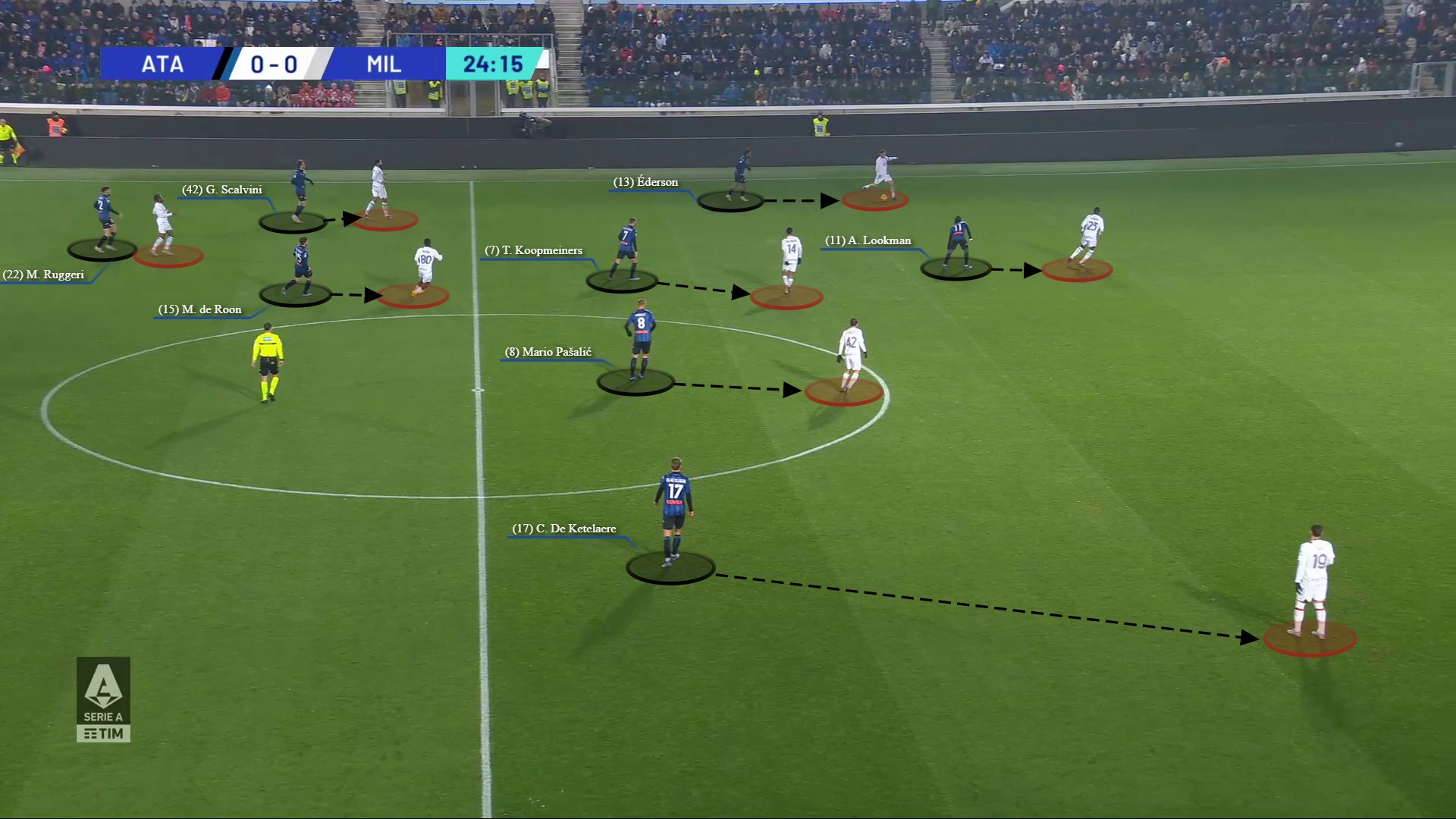
Switching positions
In the opening minutes, it was clear that in possession Milan were not necessarily going to ‘stick to their positions’ as they ‘appeared on paper’. In fact, the Milan back four and Reijnders, in particular, didn’t stay to any fixed slot, with the five players constantly switching positions in build-up phases.
What’s more, Maignan was frequently involved when Milan had the ball in their own third, acting as an auxiliary centre-back at times to create a numerical advantage. Plus, Yunus Musah and Ruben Loftus-Cheek could drop lower too to add further overload and passing angle support.
All of these tactics had the intention of baiting Atalanta forward and disorienting the first lines of their press, to ultimately manufacture (and then exploit) spaces in their defensive organisation. Another byproduct of Milan’s build-up is that it also had the added benefit of affording them the lion share of the ball.
In the opening thirty minutes, Milan had over 70% possession, as Atalanta tried to adjust to their constant positional switches. This superior possession allowed the Rossoneri to control the tempo and momentum of the game, especially in the first-half.
However, as already known by the scoreline, this ‘control’ did not translate to goals. A factor in this was of course Atalanta being well-versed at defending in this style, and effective at retreating in numbers to clog their defensive third once their press was initially beaten.
But Milan’s failure to convert (and create more) was not necessarily the fault of their build-up tactics – as they actually achieved multiple successes in using it.
Instead, Milan’s main issue was failing to capitalise upon their attacking opportunities once they reached or approached the final third. Here’s some examples to demonstrate, starting with early in the 3rd minute.
In this sequence, Maignan had the ball in the right centre-back slot, Hernández had pulled wider and Florenzi had pushed infield.
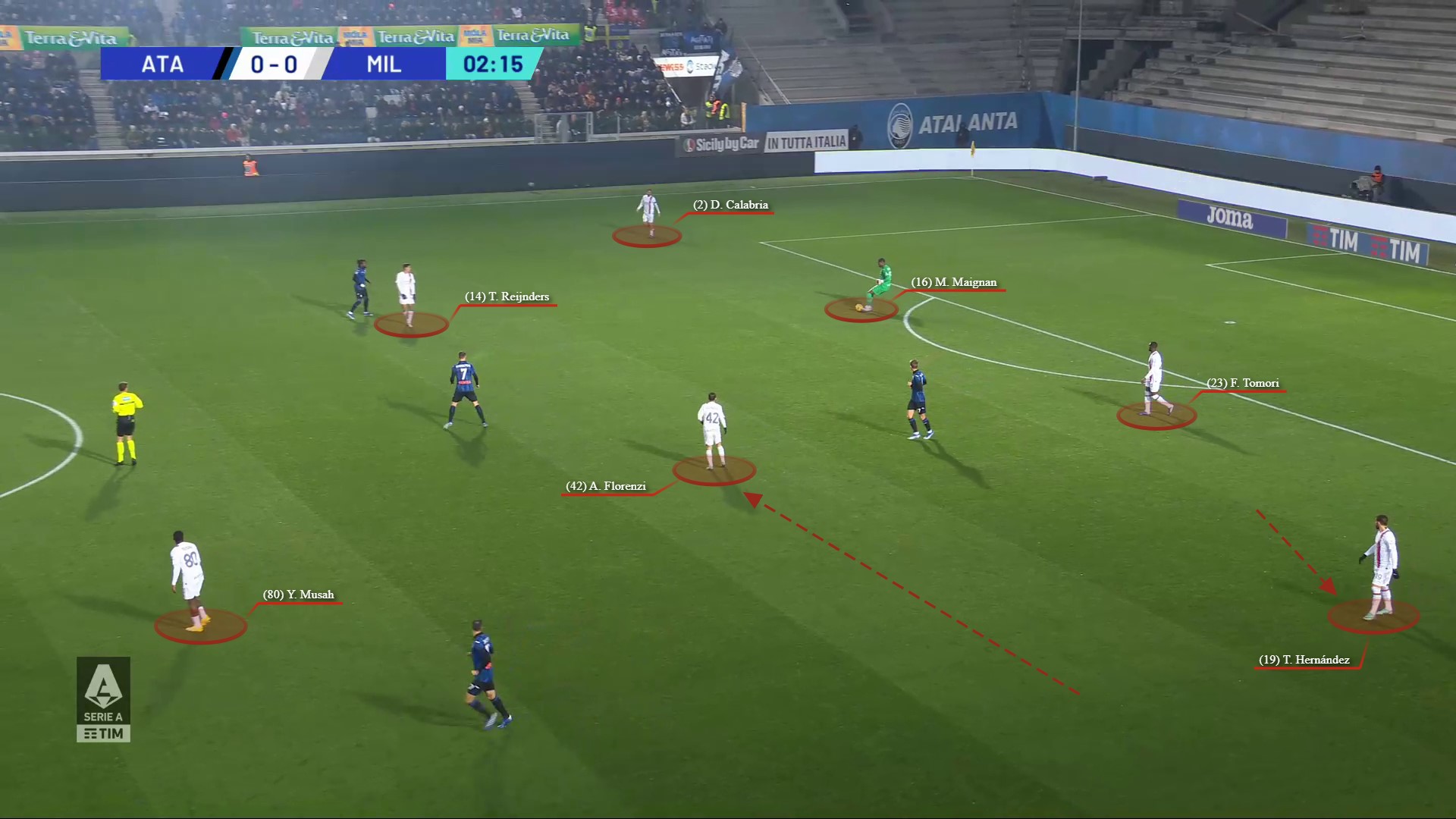
After circulating the ball along their backline, a pass back to Maignan caused Lookman to jump and as a result, Reijnders became free by moving out of his opponents cover shadow to receive the pass.

But despite having forward passing options ahead, Reijnders opted to retain the ball and turned back towards his own goal…
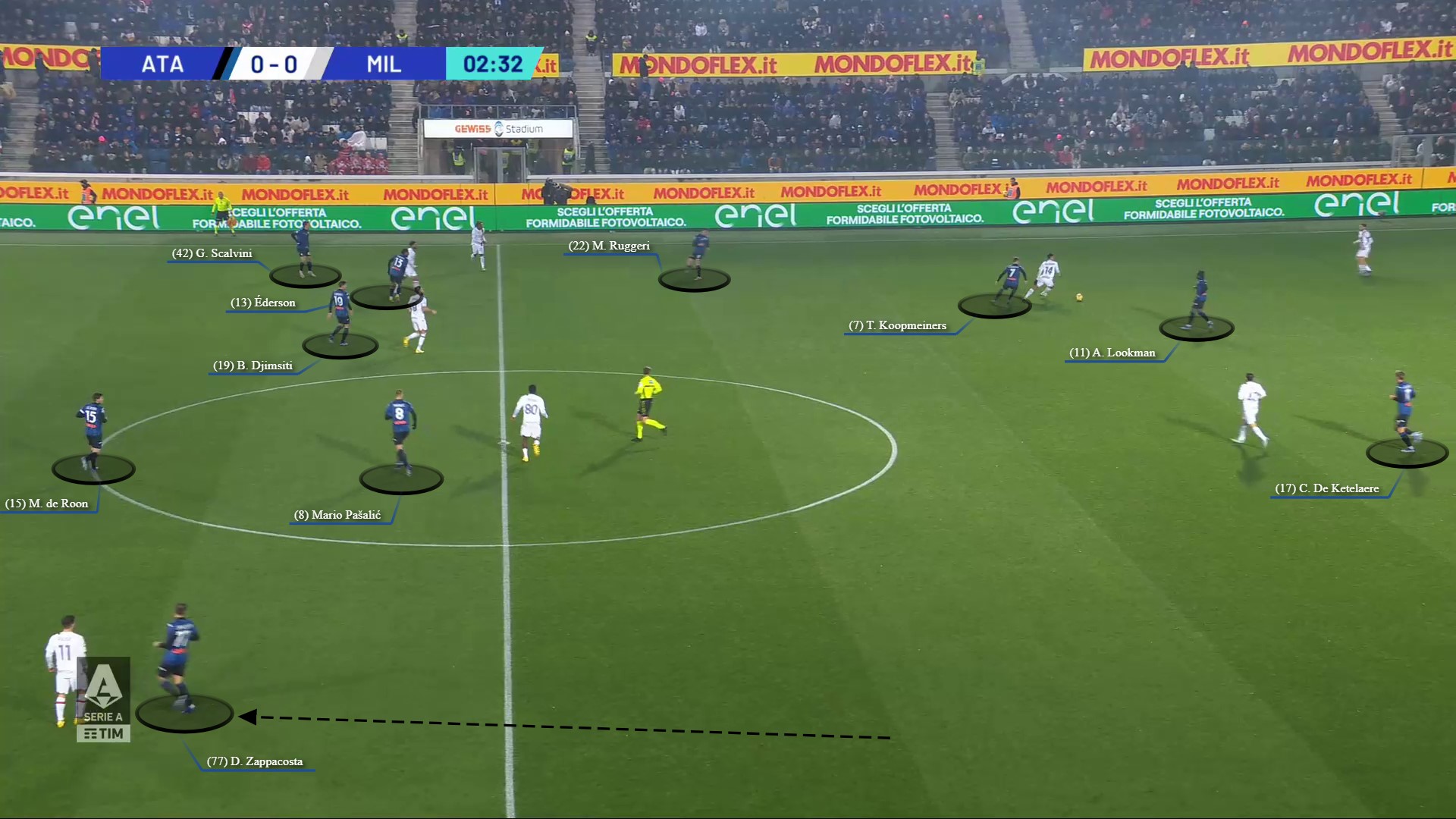
…before again utilising Maignan in deep build-up, who then found the situationally inverted Hernández with another line breaking pass.

From here, Hernández used his ball carrying ability to progress into the Atalanta half – where their backline of five had become disjointed – but his pass attempt into the final third lacked quality and was easily intercepted.
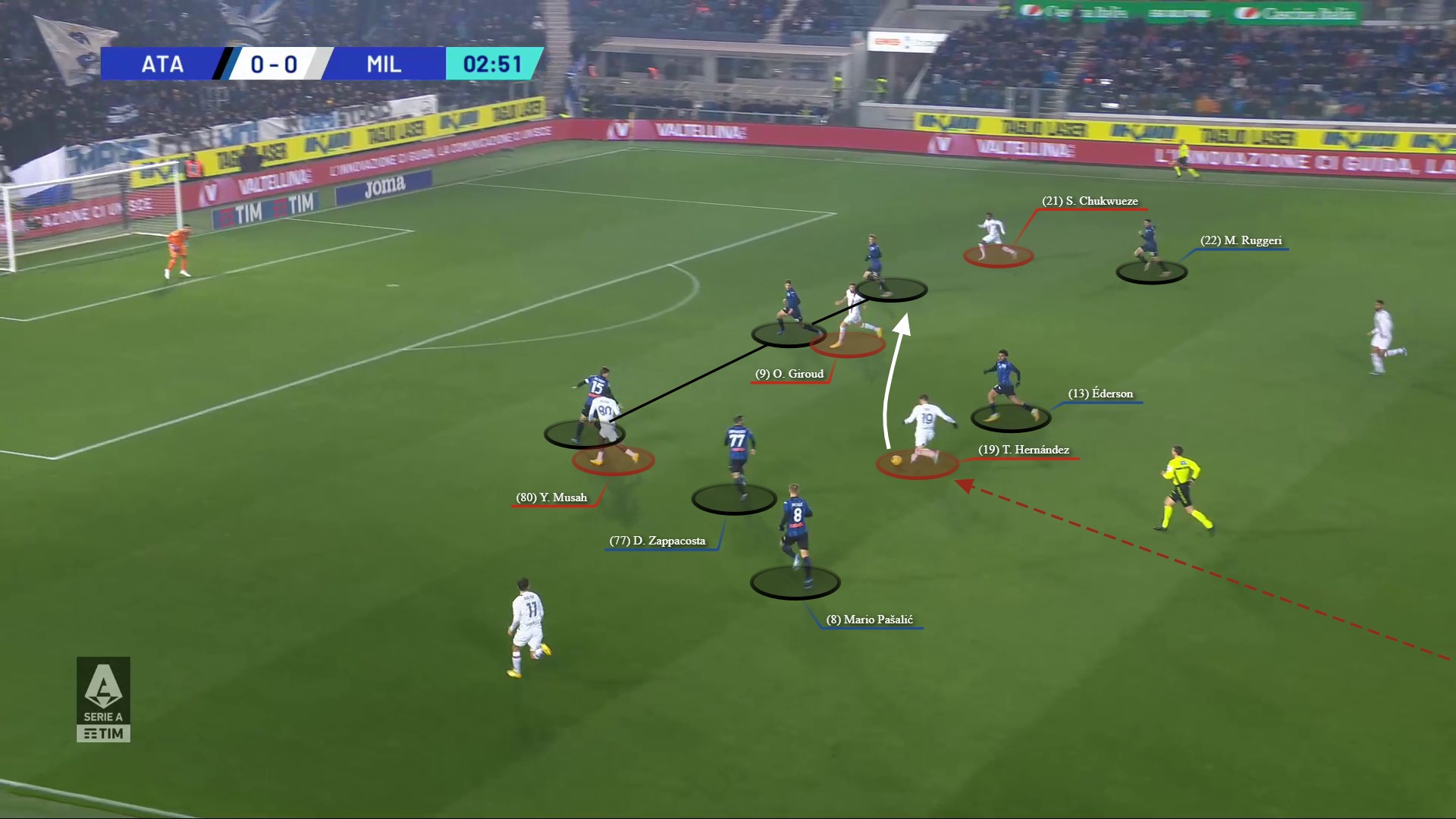
Milan soon regained possession, however, and commenced another deep possession sequence. In this passage, early in the 4th minute, Milan worked the ball over to their right-hand side, first accessing Calabria who then passed forward to the dropping Chukwueze on the touchline.
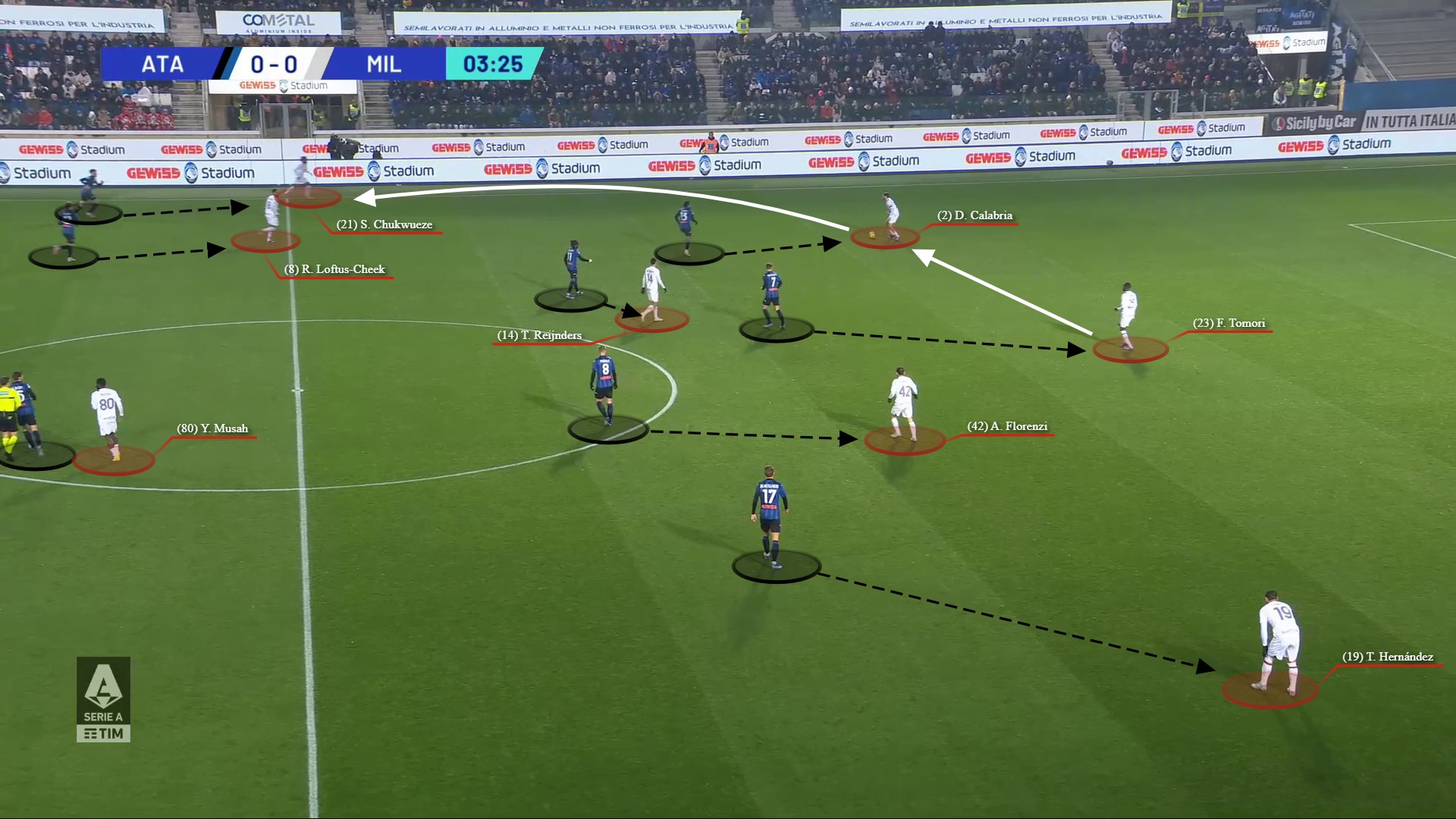
As Chukwueze had drawn his marker out by coming short (likewise Loftus-Cheek), the Atalanta backline had again become disjointed (see back three each highlighted below), and with Giroud dropping into the vacated space in behind the opposition midfield, a pass was made into the French forward who immediately sprayed another pass out towards the left-wing…
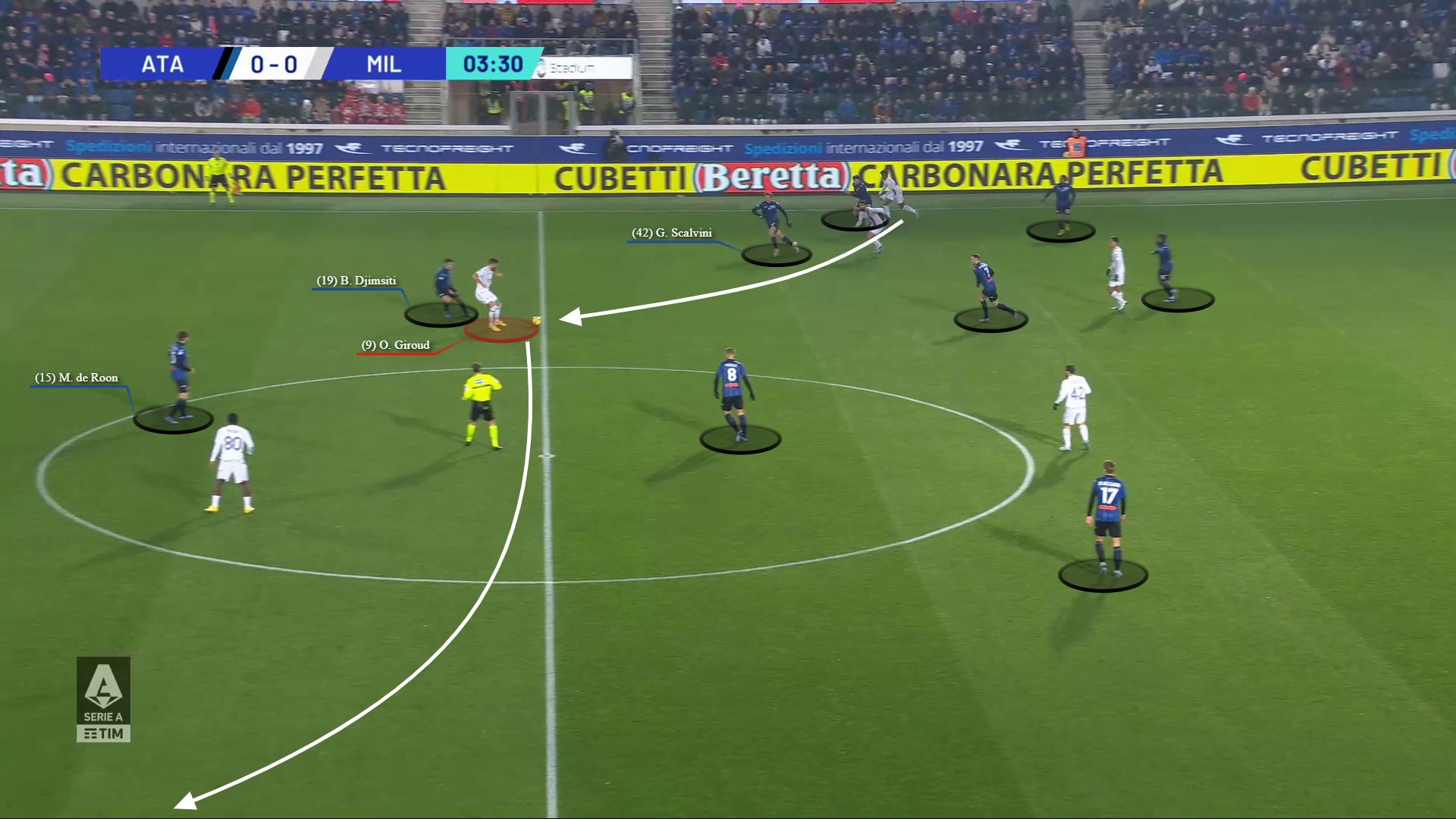
…where Pulisic was initially 1v1 against the right wing-back. The USMNT carried infield and then combined with Giroud to get in behind the now fully retreated Atalanta backline. (Note, despite having seven players ahead of the ball in the image above, in the visual below, Atalanta had managed to retreat in numbers to protect their box, highlighting their part in limiting Milan’s attacking threat).
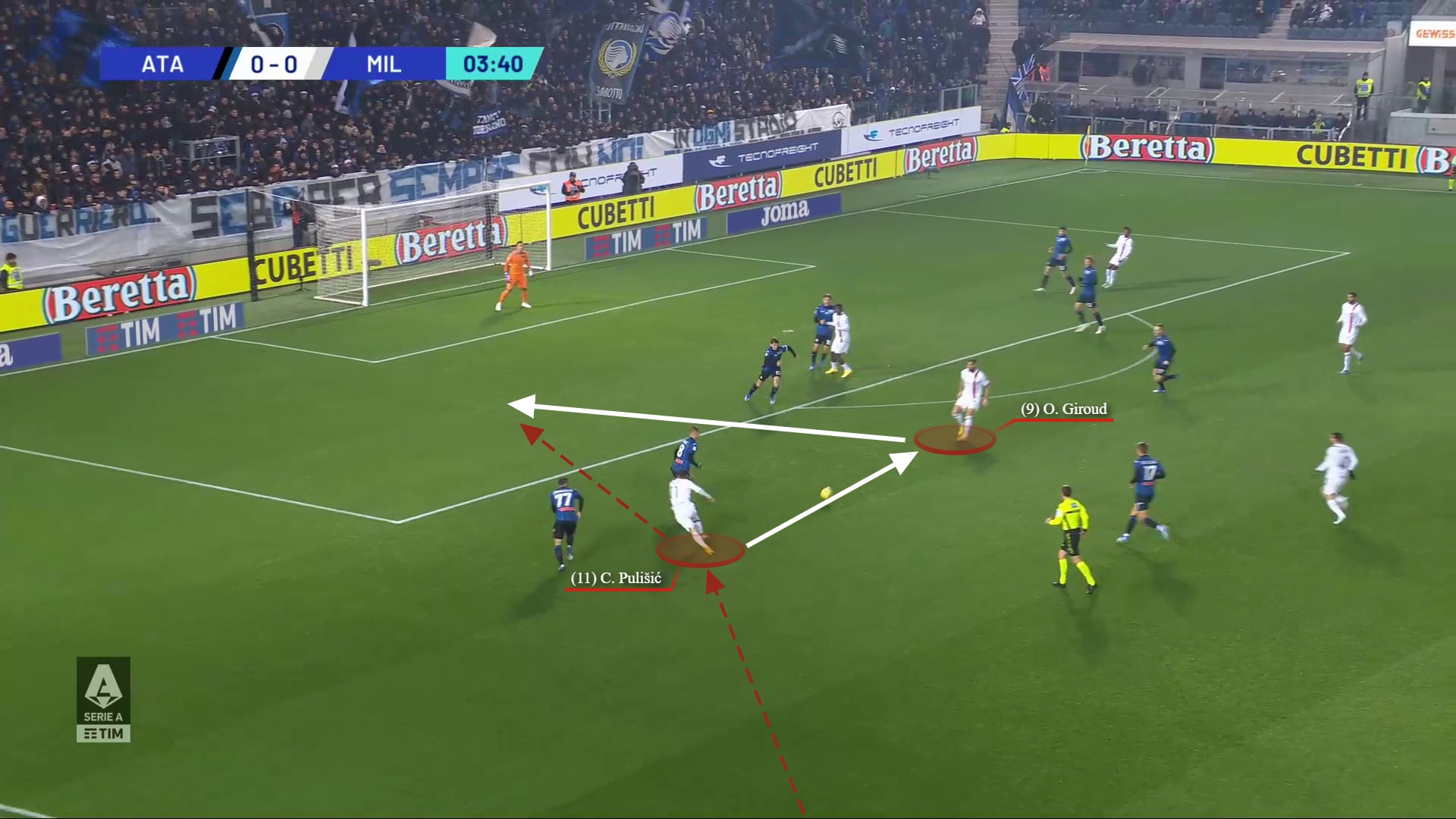
After receiving the ball inside the box, Pulisic fired across the face of goal but neither Musah or Chukwueze managed to get ahead of their marker to win first contact. The attack was not over though, with the loose ball ending up at the feet of Giroud, but his shot was blocked by the nearby defender.
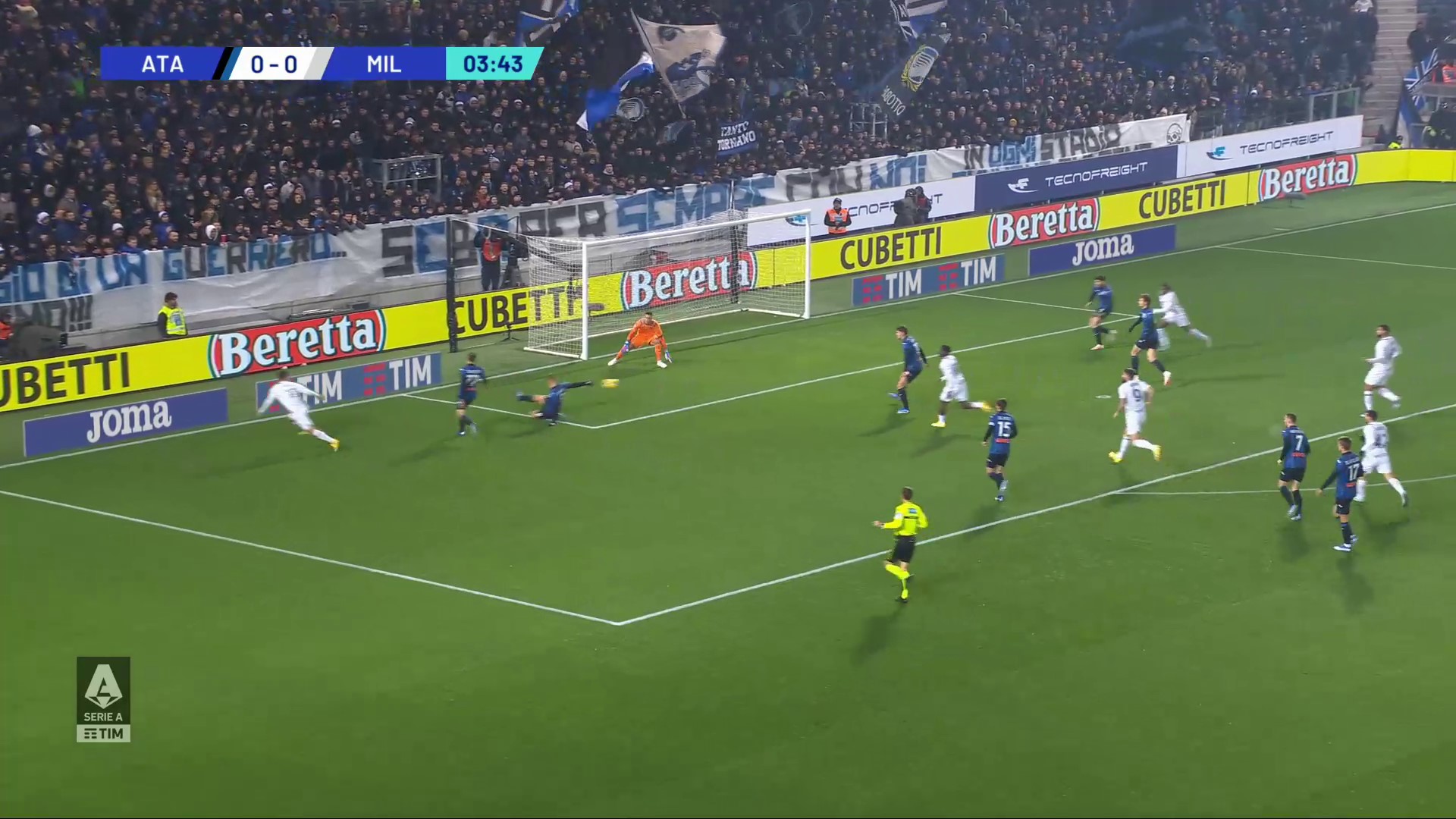
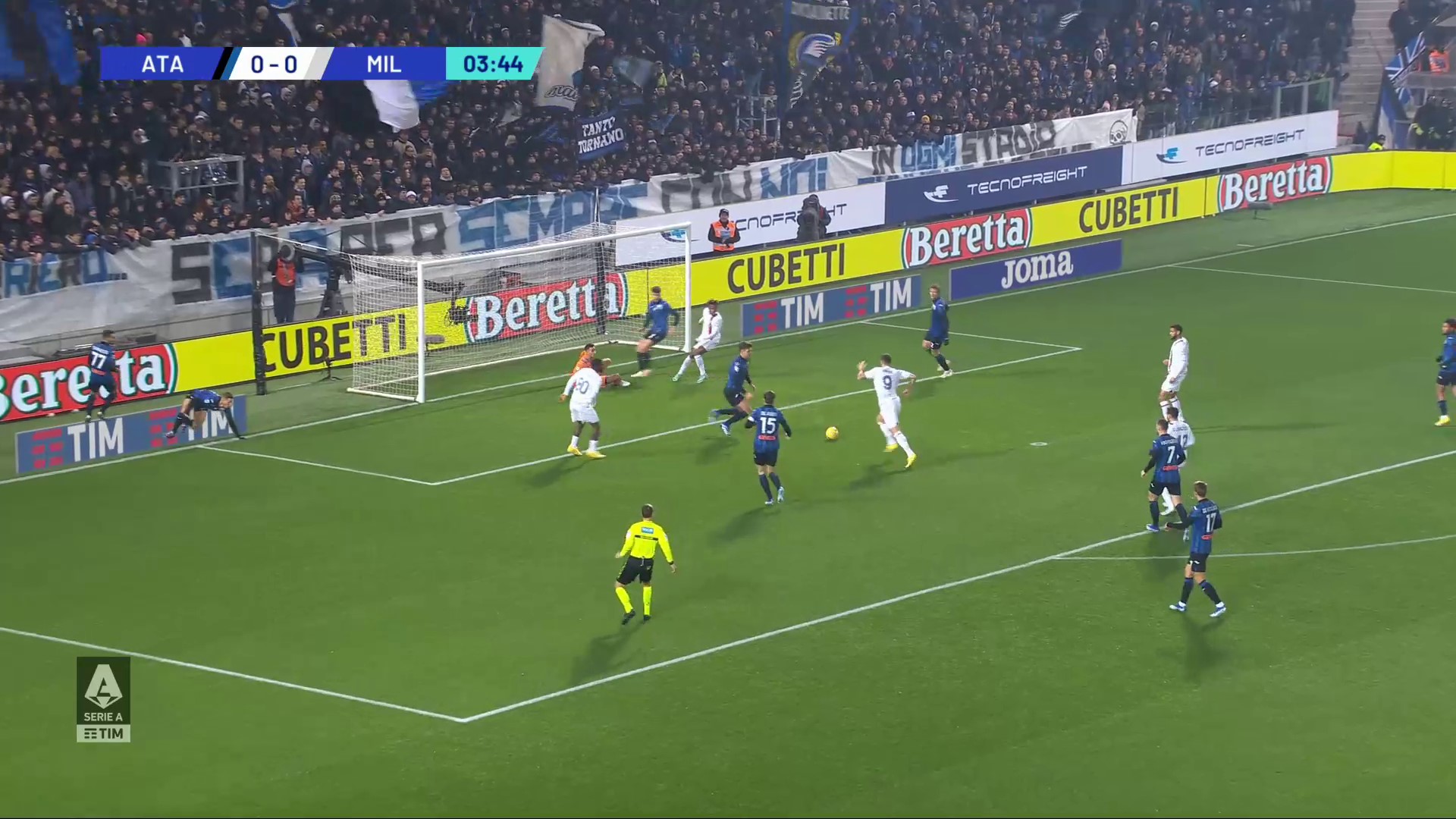
Two attacks in less than a minute, and Milan did not have to wait too much longer for their next.
In the 8th minute, the Milan players were again switching positions in build-up, and as a result Calabria found space deep on the right wing. Below, you can see Loftus-Cheek signaling to Calabria to carry forward once he received the ball.
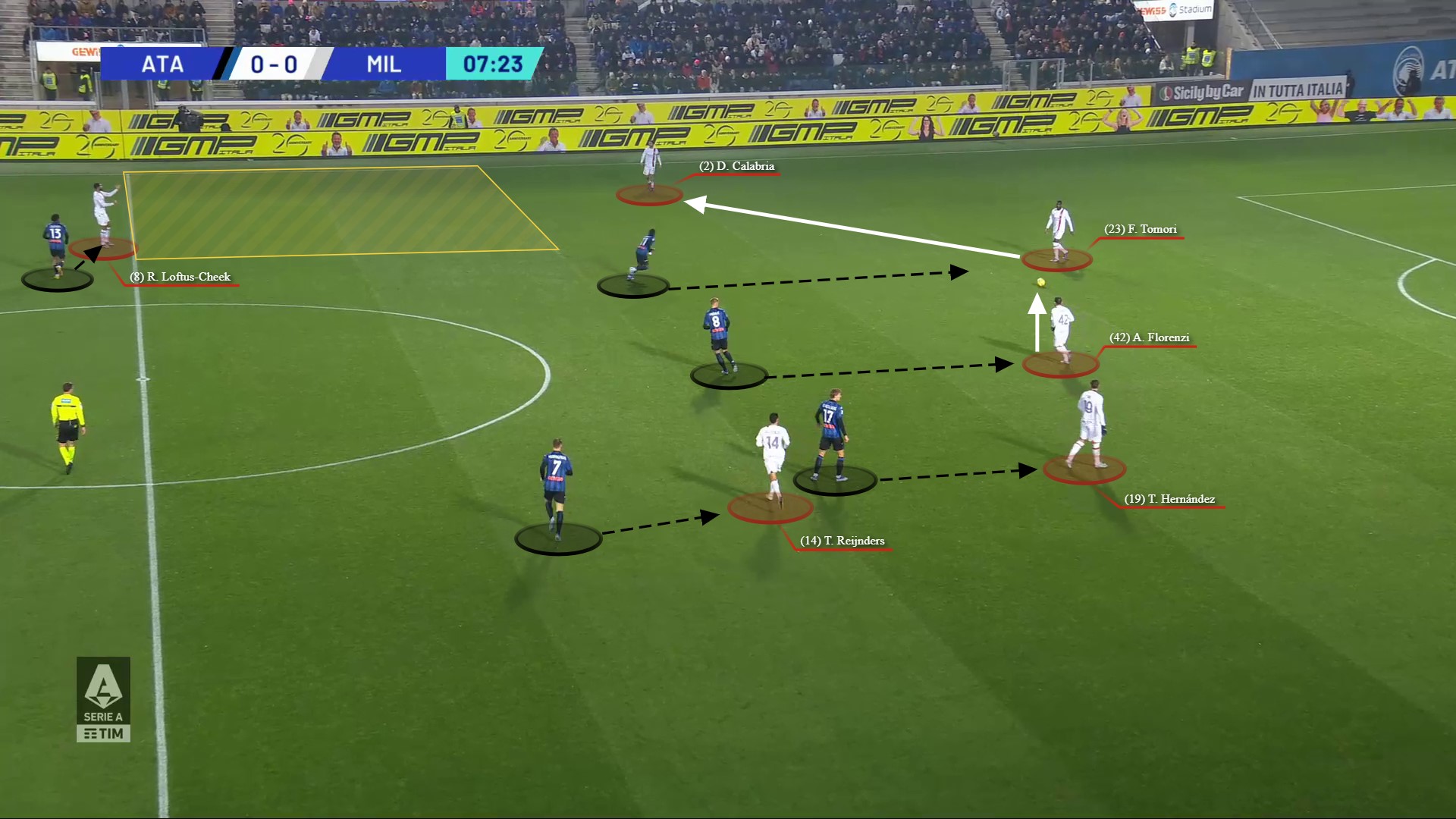
And whilst the right-back (probably Milan’s most fixed player positionally in build-up) did not advance too far forward once in possession, it did not matter, as his mere receipt of the ball triggered a jump from the Atalanta backline to go and engage, in this case left wing-back, Matteo Ruggeri.
With Milan now satisfied there were potential spaces to exploit in the Atalanta half, Loftus-Cheek and Chukwueze made opposite movements, and Calabria played a pass into the channel…
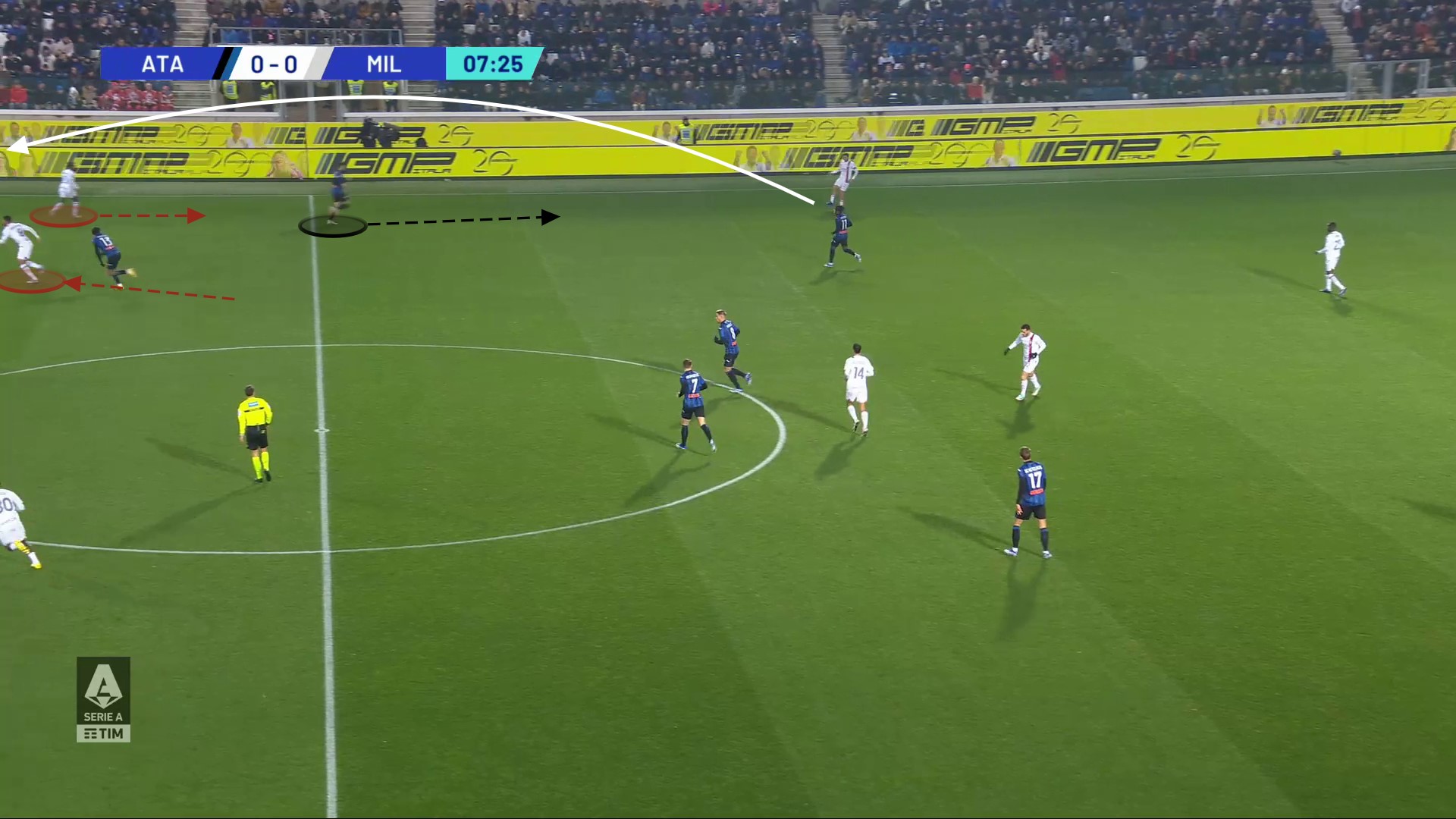
…where Loftus-Cheek did receive in space. In the image below, you can now also see that Giroud additionally came short which helped further exacerbate Atalanta’s disjoined backline by pulling out Berat Djimsiti too.
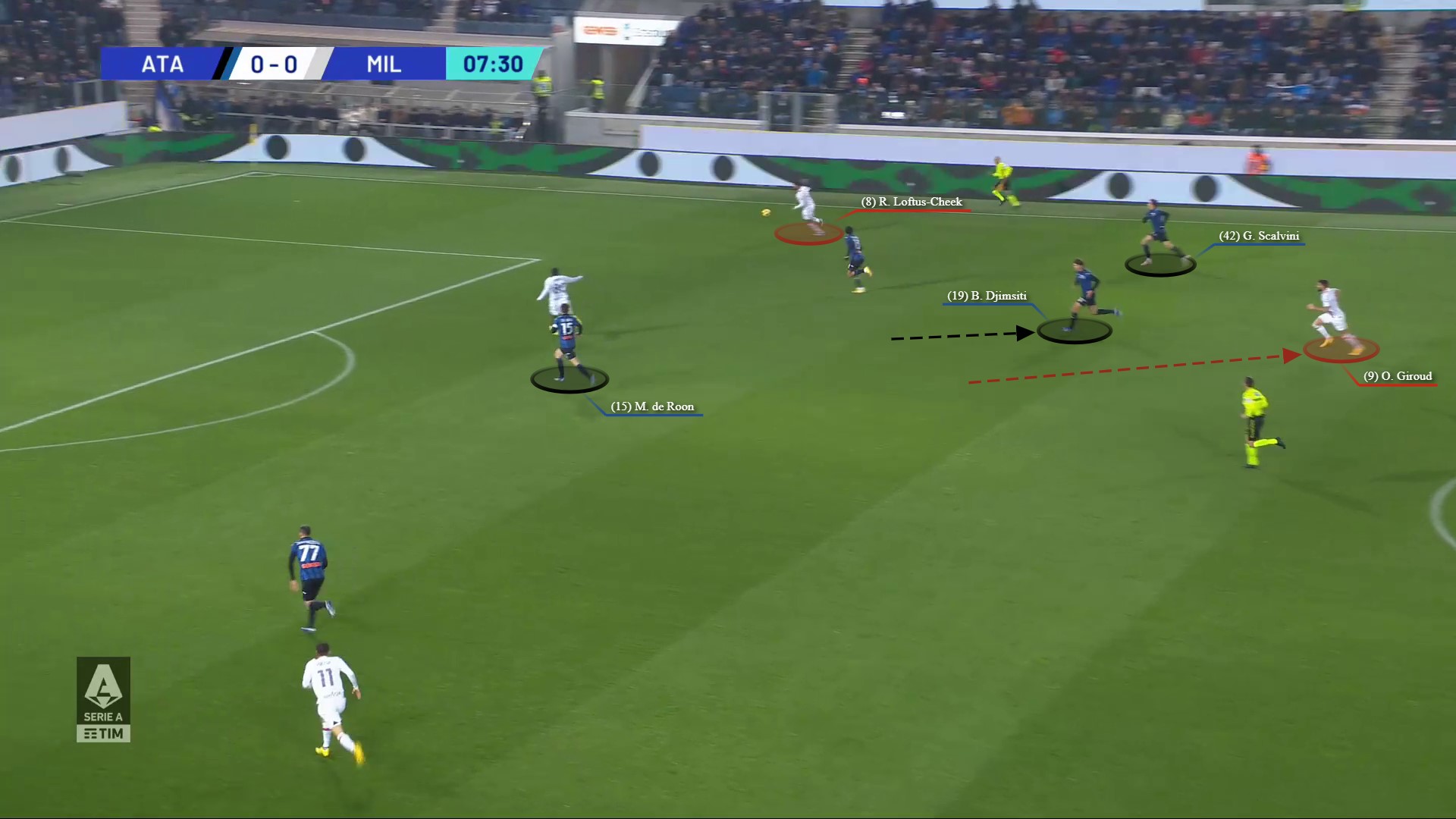
It was, however, Djimsiti who recovered to clear Loftus-Cheek’s low cross into the box. A promising attacking moment which failed to materialise into any attempt on goal.
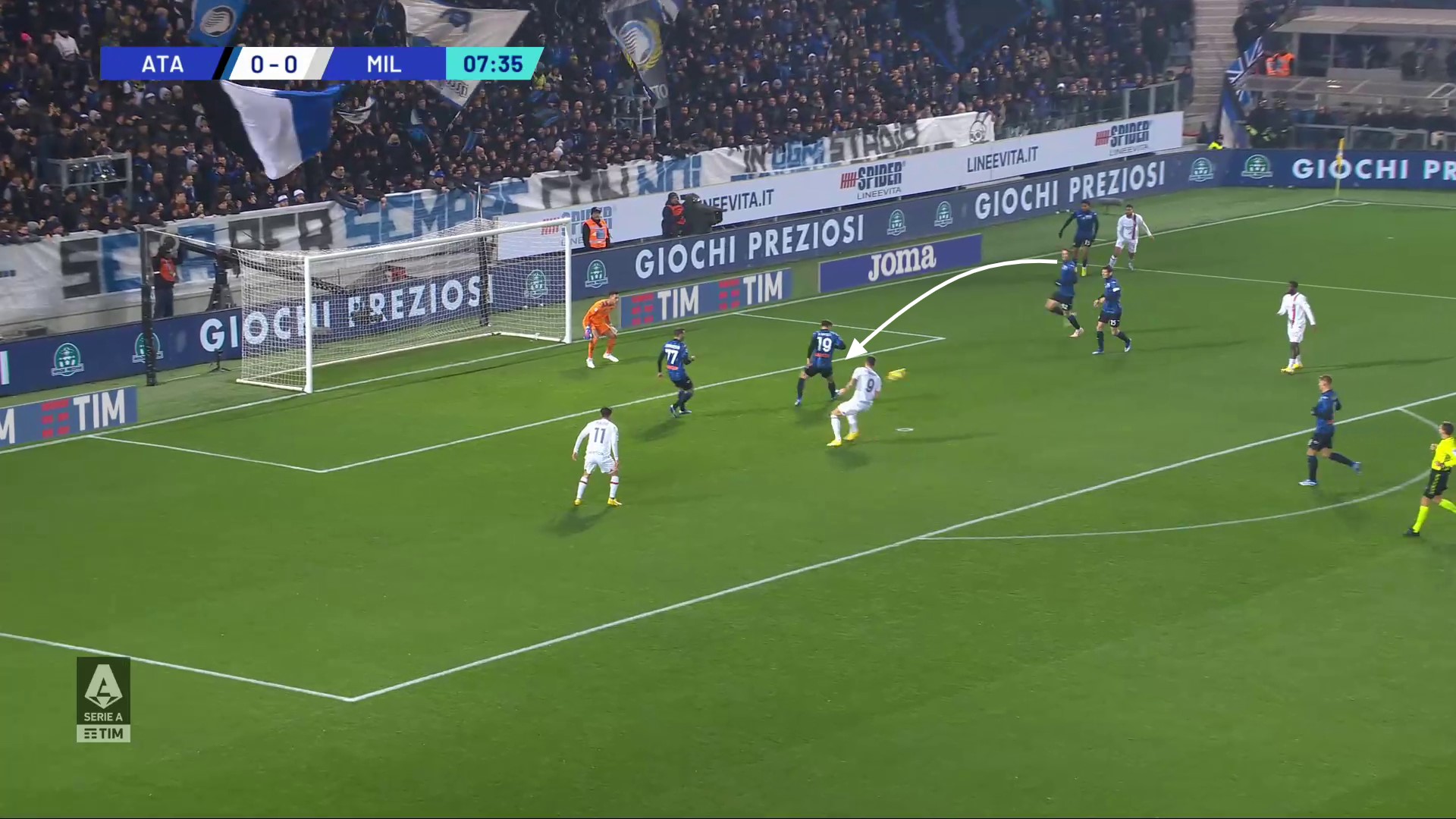
This theme continued in the 14th minute. Milan began their build-up sequence with a pass out wide to Hernández, in his more familiar left-back slot. Take a look at all of the Milan players’ current positions…
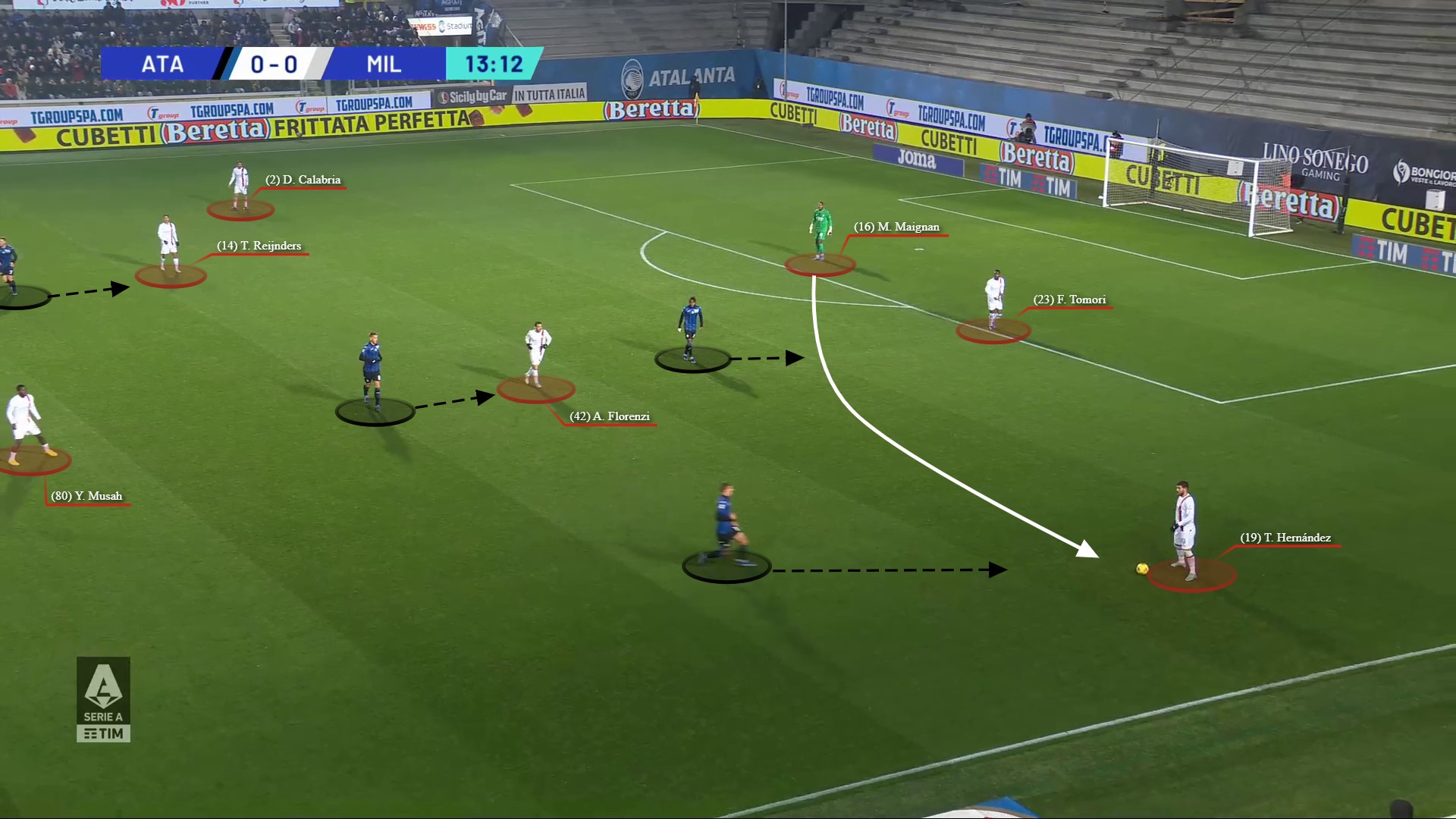
…and then fast forward 25 seconds, where after continuous possession – and lots of positional switches which helped draw Atalanta upfield and onto different opponents – Milan had again manufactured space in behind the opposition midfield.
As a result, Tomori attempted a pass into the feet of the dropping Giroud, but the lack of accuracy resulted in a ball loss and another potential attacking opportunity going awry.
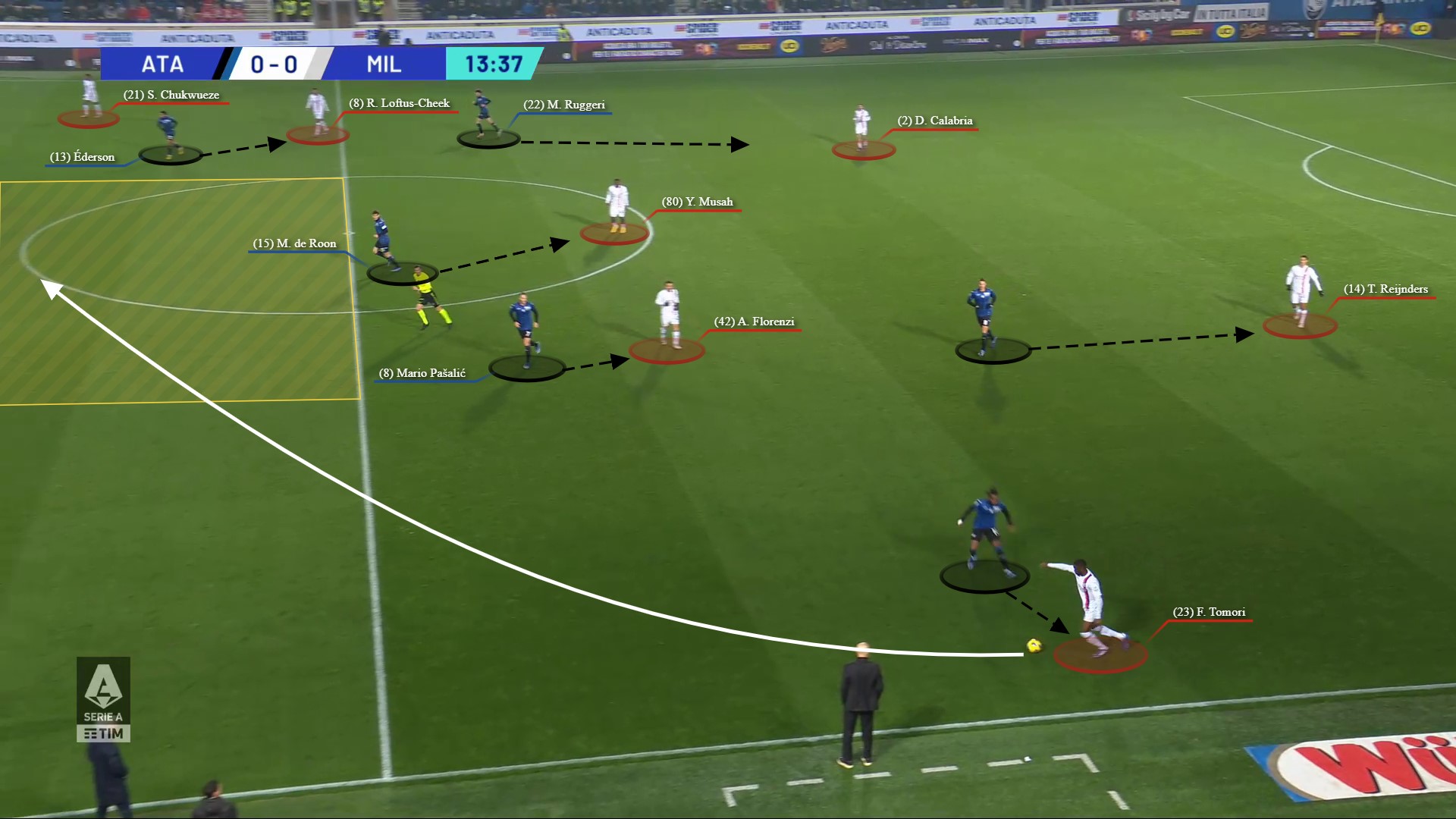
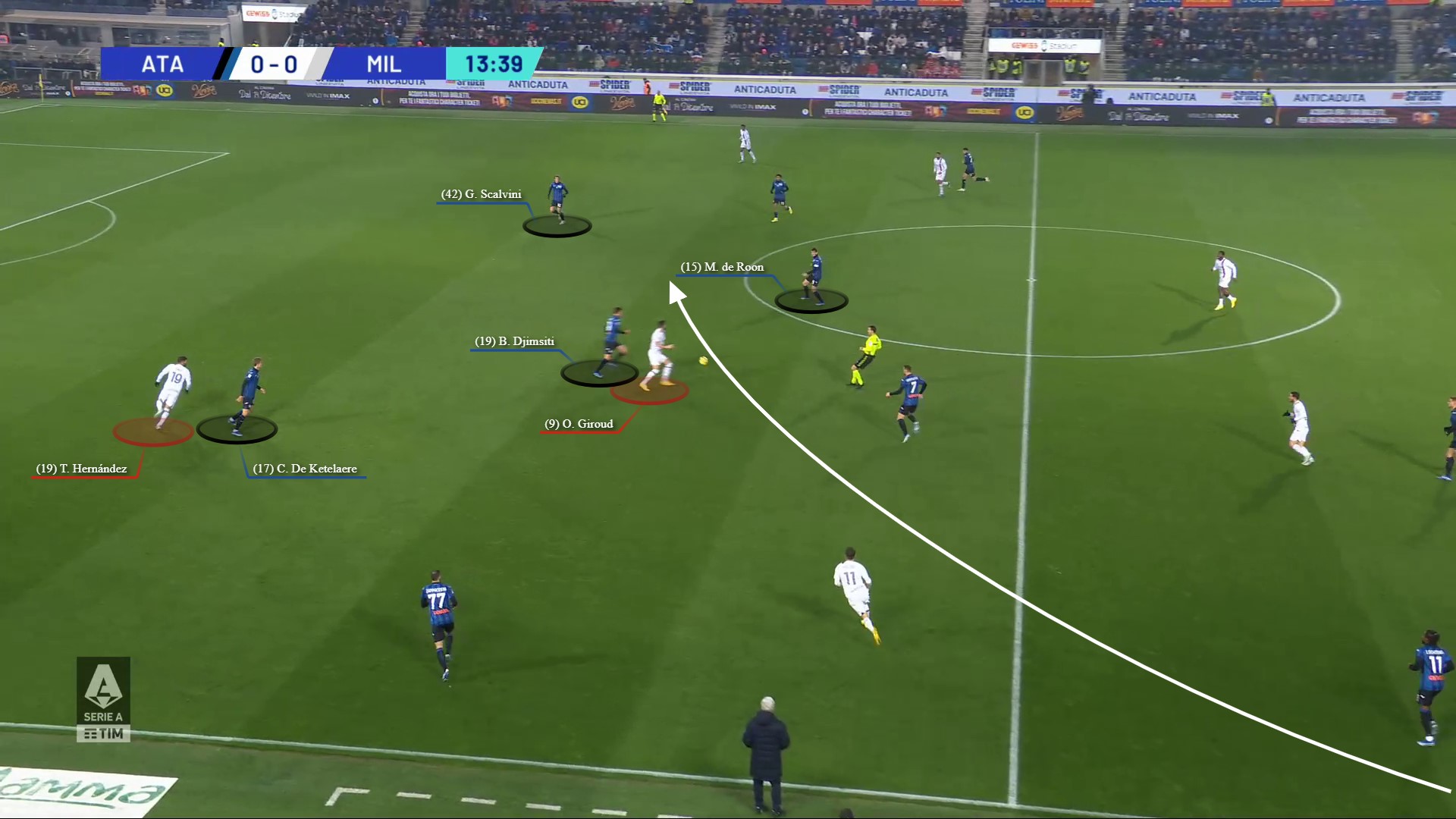
In this next example, at the end of the 28th minute, Milan’s possession sequence started with a freekick deep in their half. Twenty seconds later…
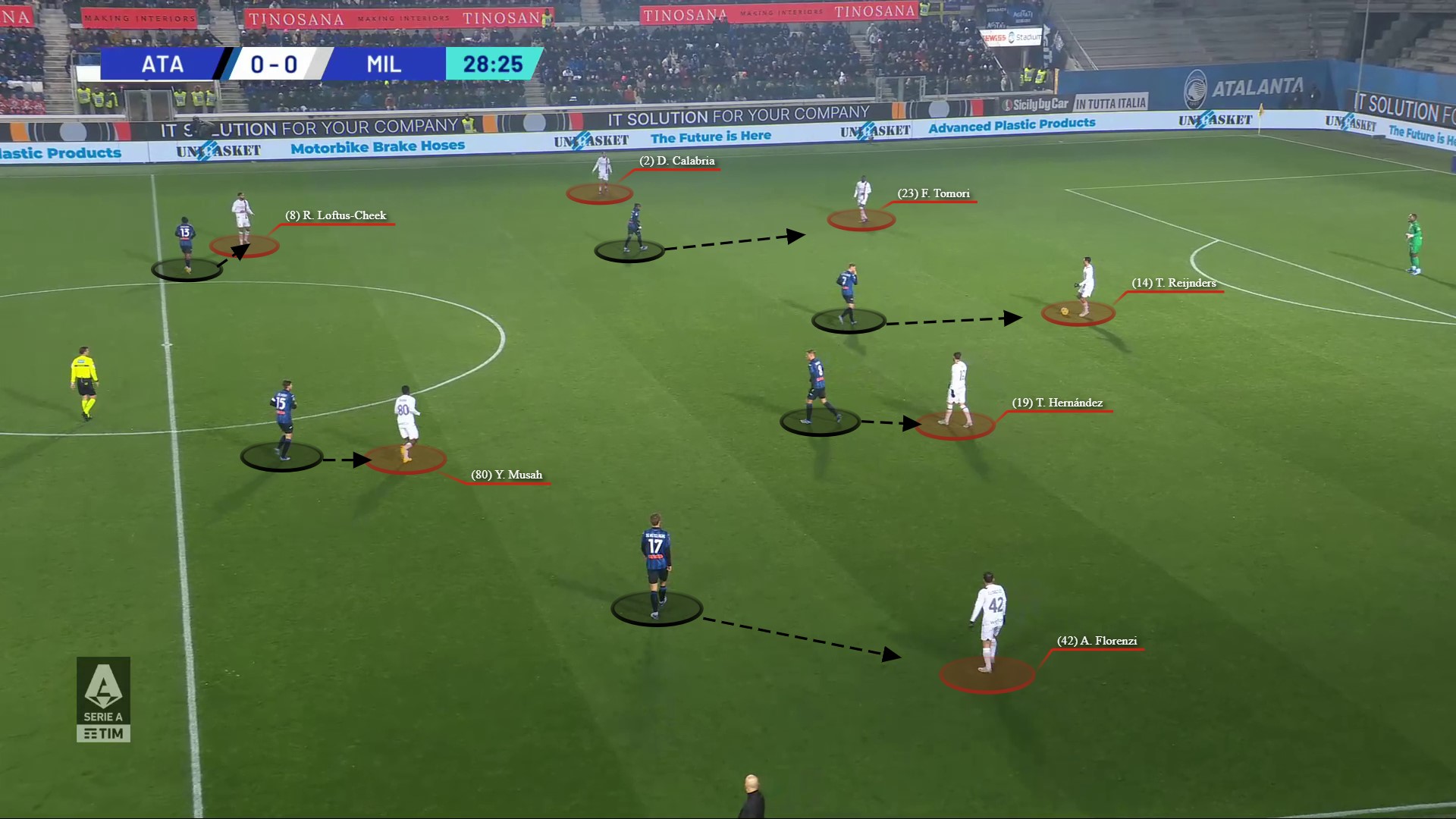
…a number of the Milan players are in different positions (most notably, Musah who was on the ball and Florenzi – out of shot – who offered a depth run in behind). As usual, from here, Milan maintained possession and continued to switch the areas in which their players were positioned to disrupt the Atalanta defensive organisation.
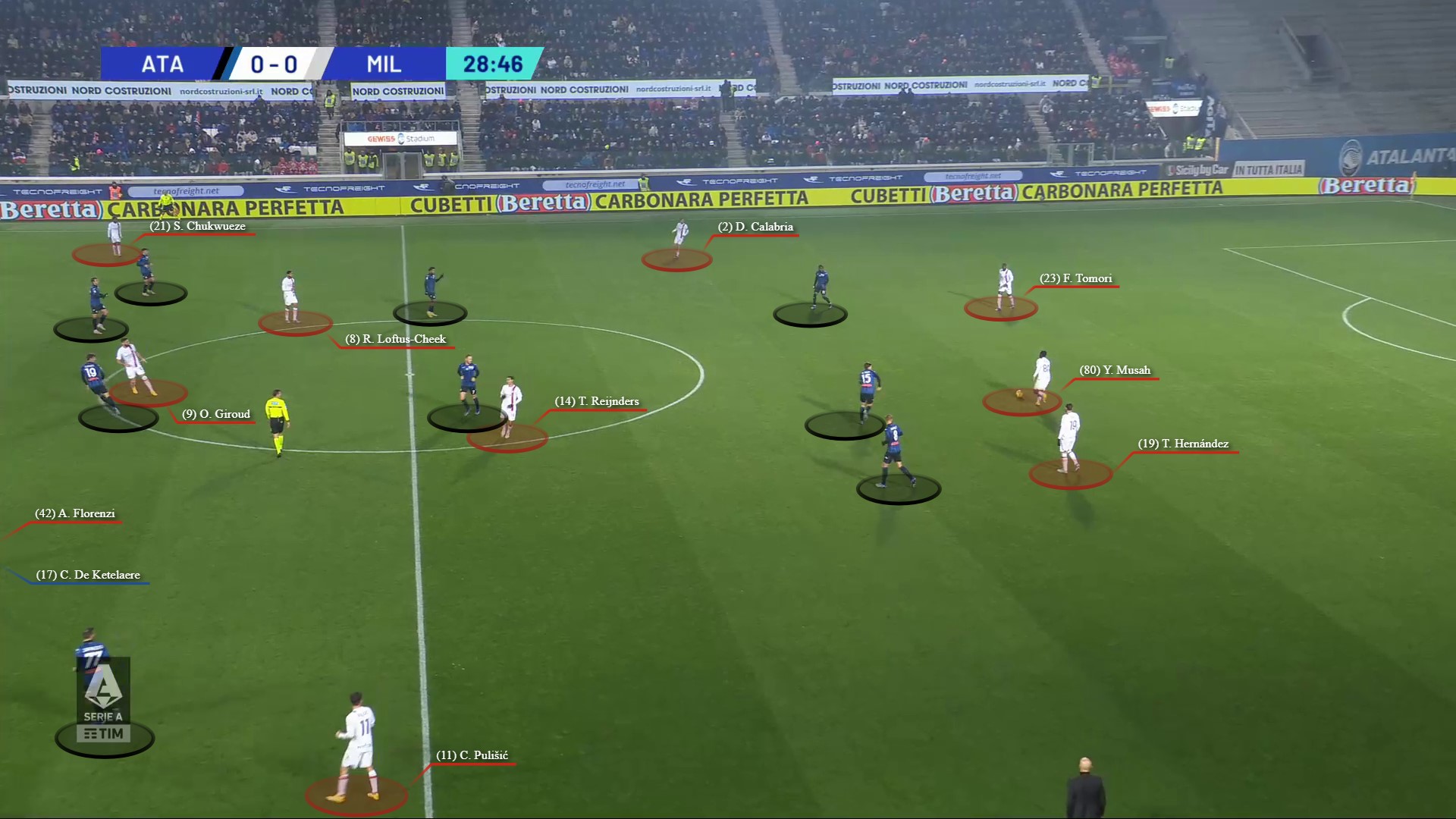
One particular issue which Atalanta were frequently faced with was who would jump to engage Calabria – often the initial free man in Milan build-up. In the early stages of the game, Éderson was tasked to jump up from central midfield but as seen, this was often causing Atalanta to vacate space in central areas. Therefore, Atalanta began to trial different solutions, with the left-side of their backline, Ruggeri and Scalvini, given the responsibility.
But as seen below, Milan could also use this to their advantage. Here, Calabria received possession in the middle third, causing Scalvini to jump and engage. This was a trigger for Milan to exploit this newly manufactured space, with both Musah and Chukwueze attacking this area.
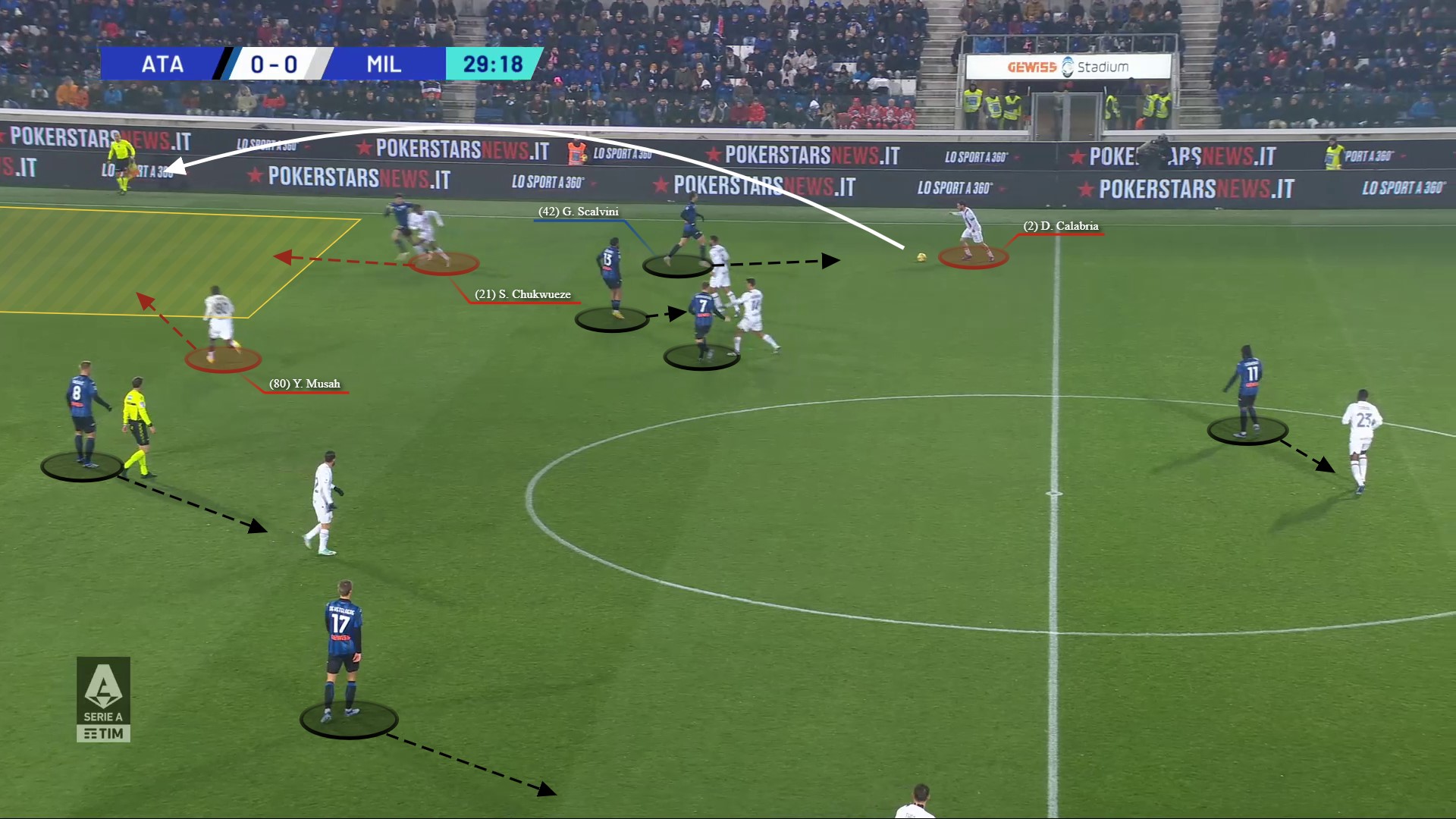
Musah collected the pass, laid back to Chukwueze who then passed into the box to Giroud. The striker was fortunate with his lay off attempt, but the ball still found its way to Reijnders in space outside the area, however, his ambitious strike safely sailed over the bar.
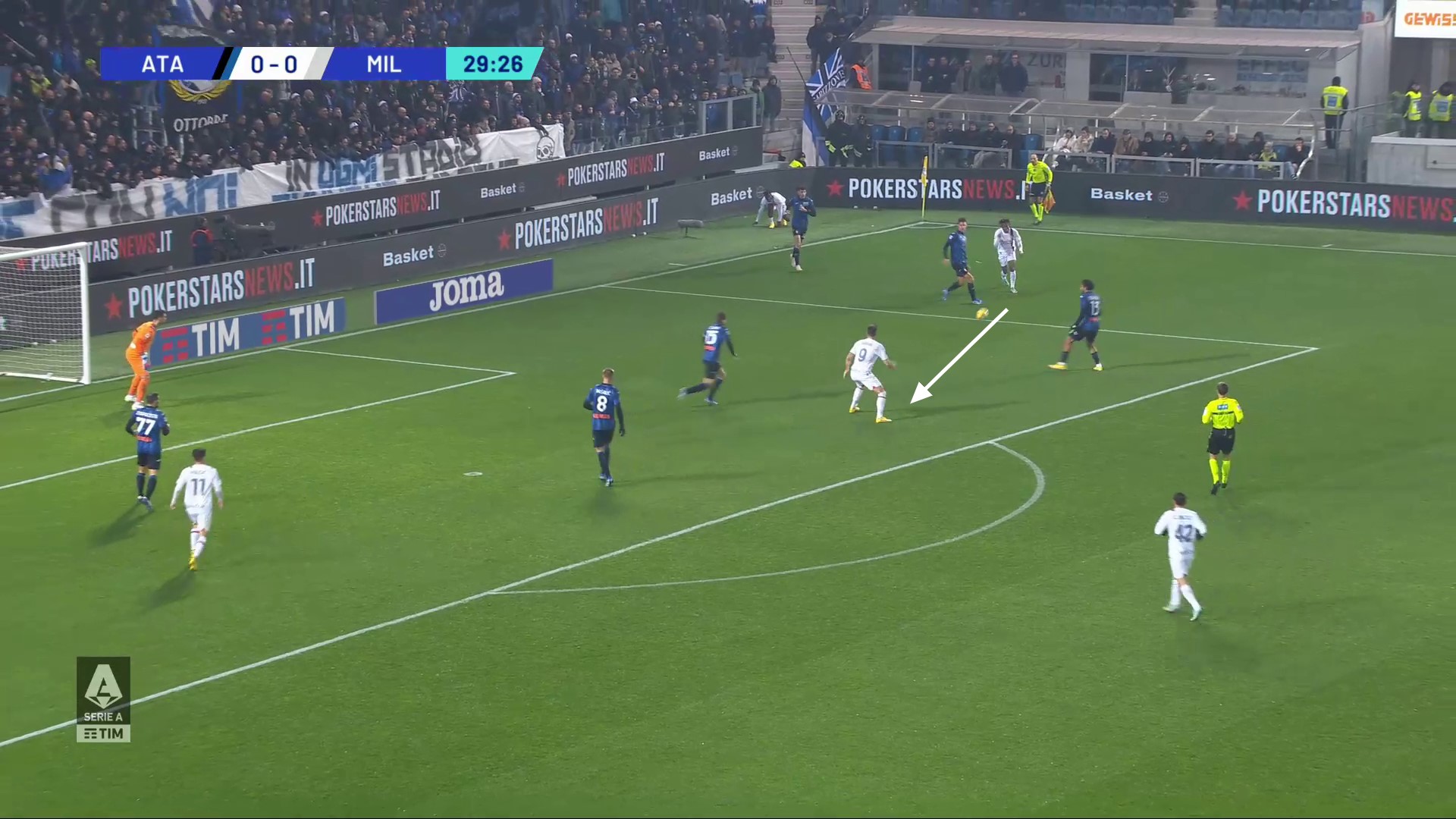
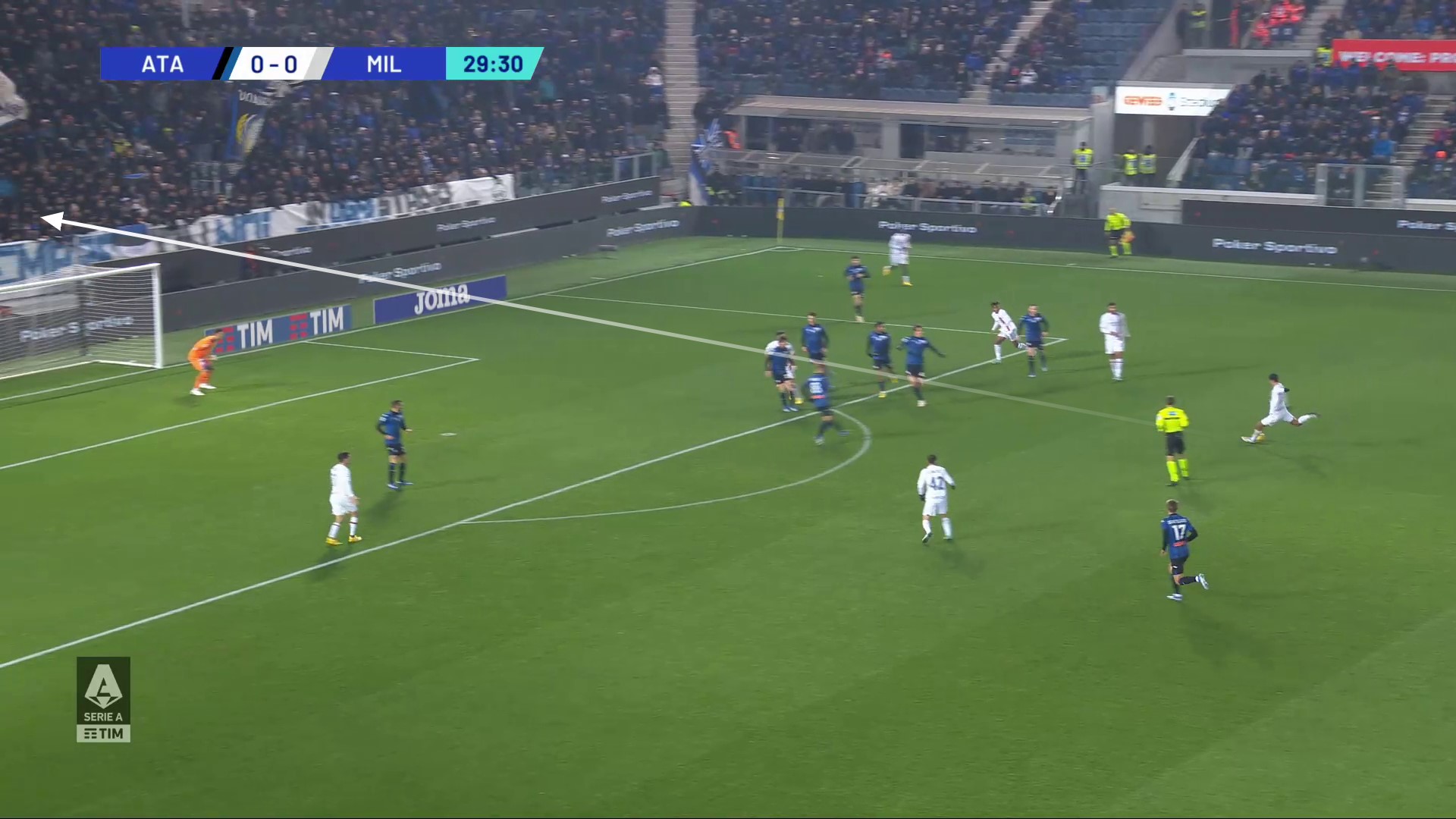
A couple of minutes later, Milan again attempted to attack down their right wing. The passage of play started on the left with Hernández passing forward to Pulisic and then the two crossing over. Florenzi dropped to cover the advanced Hernández in the backline (a regular occurrence) and with no progression options available, play was recycled before being circulated out to their right-hand side.
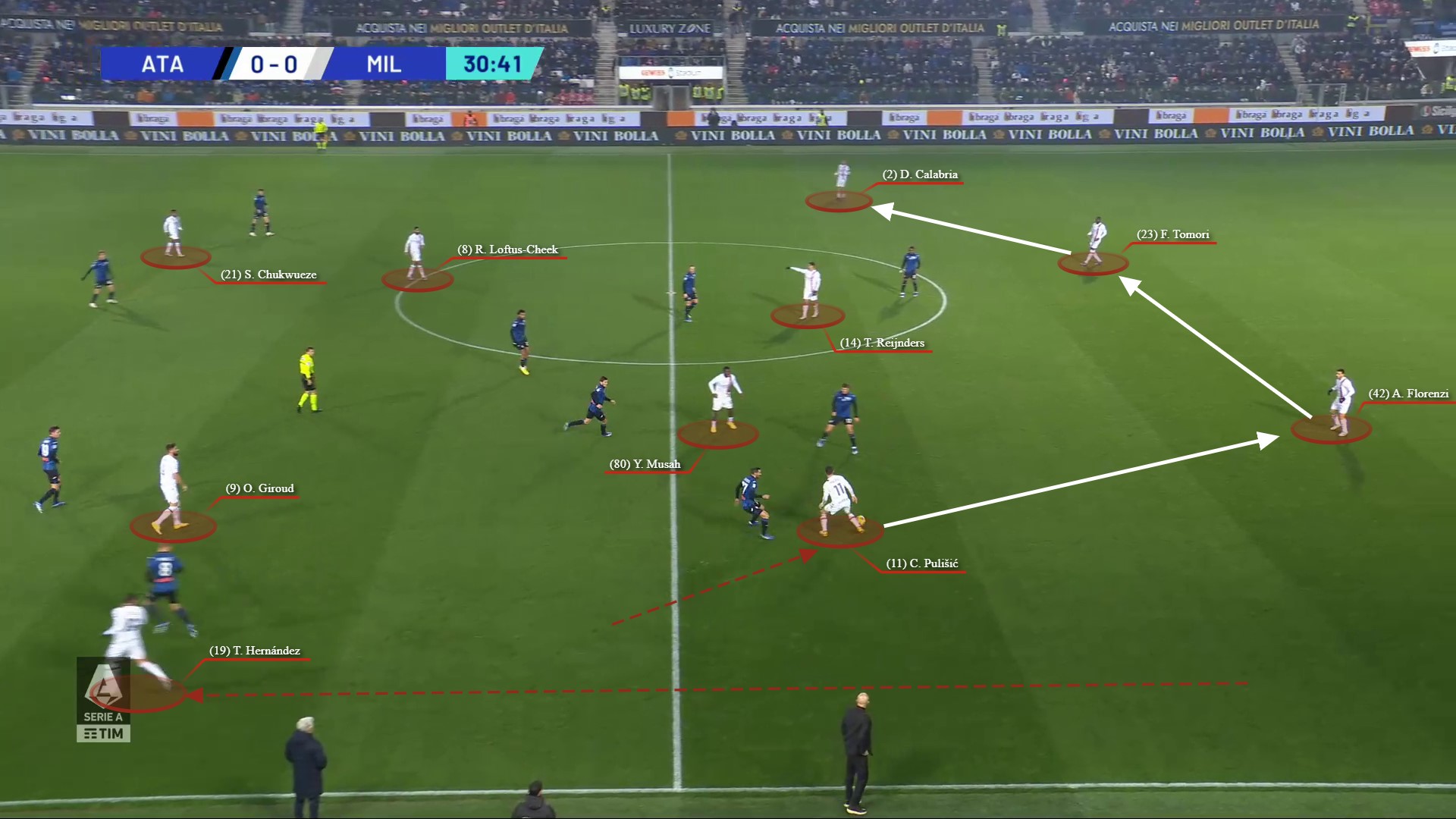
Once Calabria received, again initially in space, it was this time Ruggeri’s job to jump. Milan then executed a passing combination to access the space where Ruggeri had just vacated to find Chukwueze in a 1v1 situation against Scalvini…
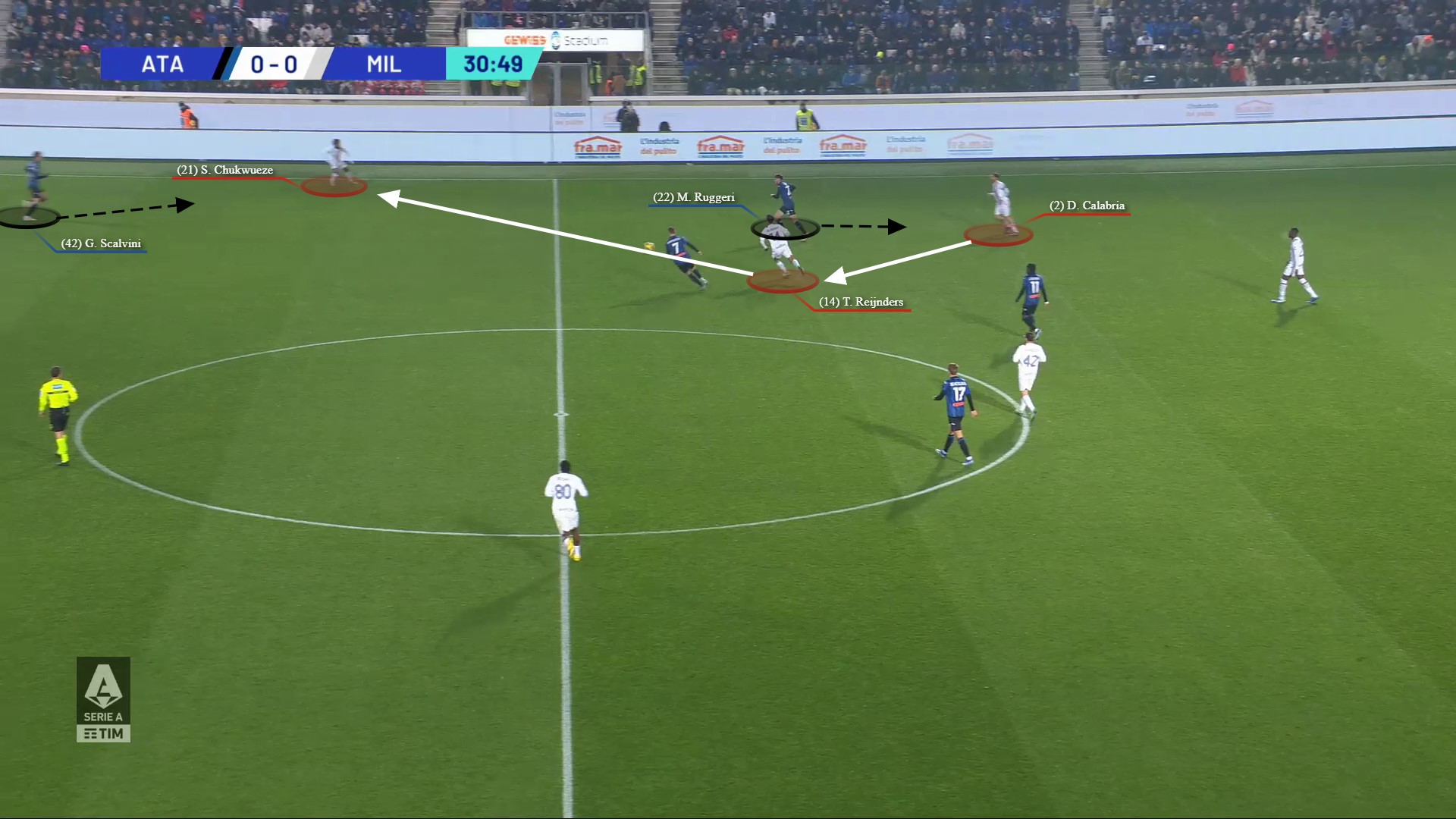
…which the Nigerian easily won before passing infield to the advanced Reijnders. However, the Dutch midfielder failed to scan and was tackled by the retreating midfielder on his inside, resulting in the promising attack ahead, and to the left (see Hernández), being prevented.
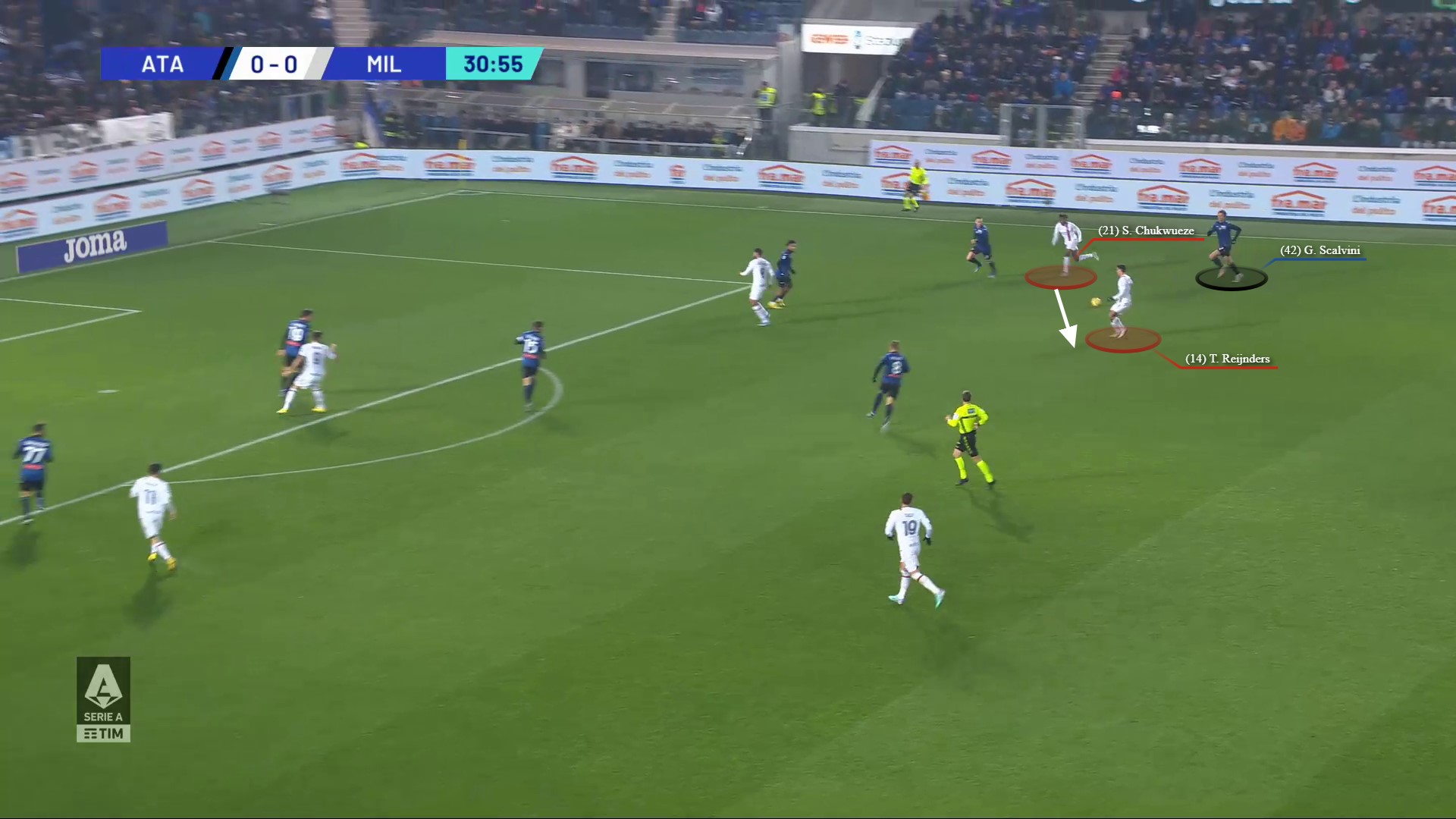
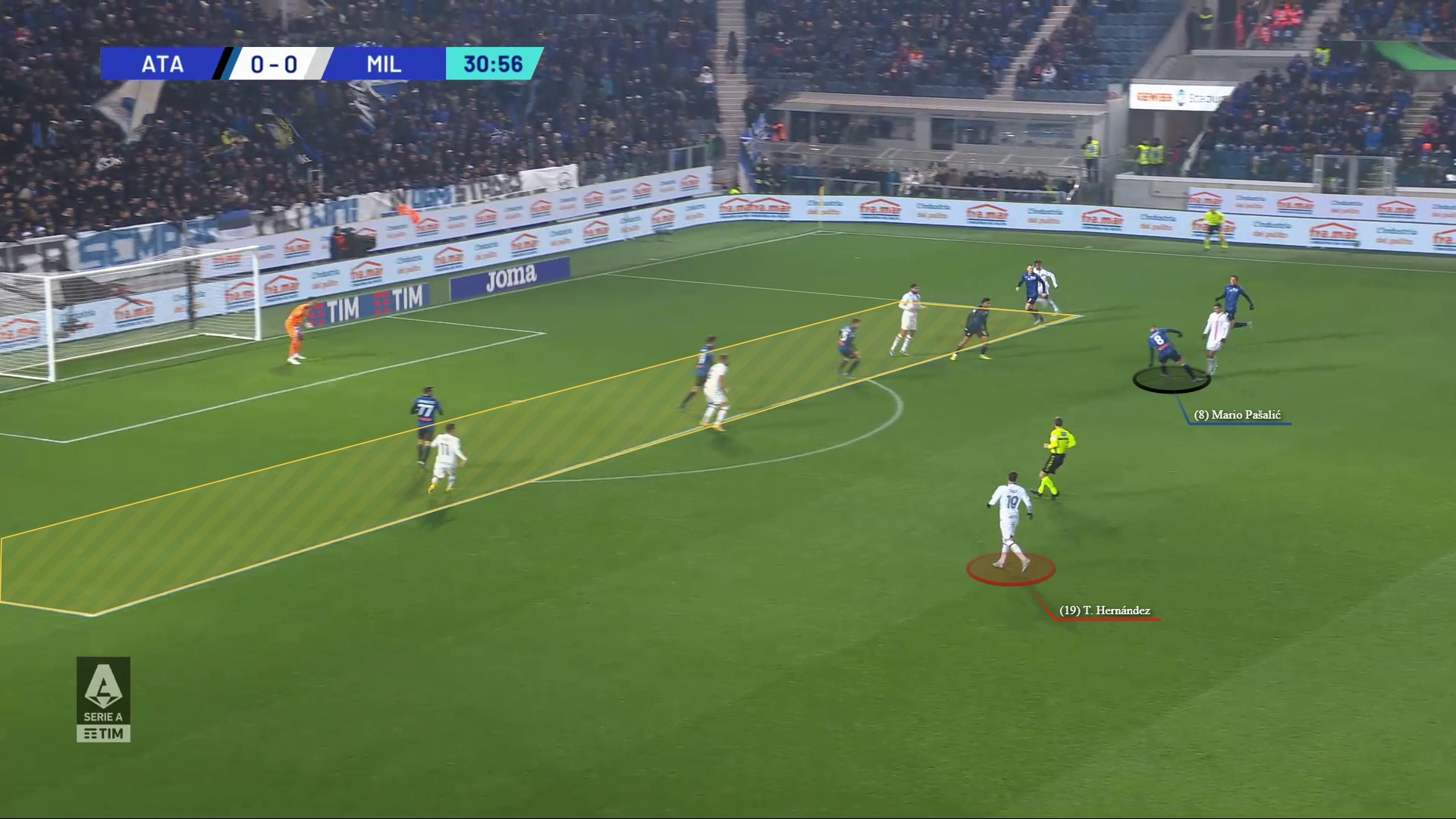
In this final example from the first-half, Milan circulated possession back towards their own half to draw Atalanta out. Tomori and the inverted Florenzi exchanged passes to ensure the opposition midfield had been sufficiently baited which created space in behind to exploit.
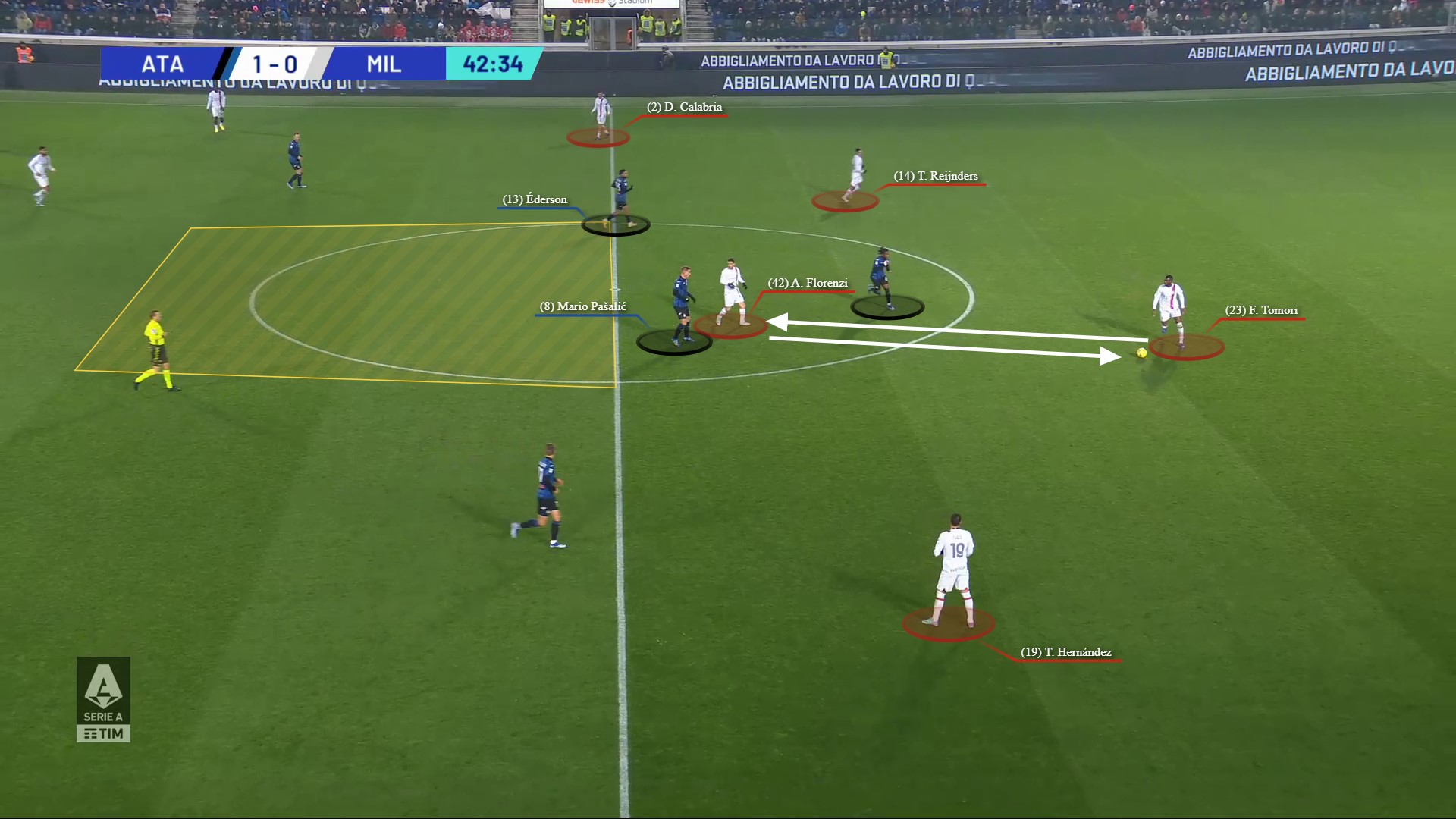
Queue Giroud coming to feet to offer a progressive passing angle for Tomori, and then play a first-time lay off to the expectant Florenzi who anticipated the pattern of play to steal a march on his opponent with his off-ball movement.
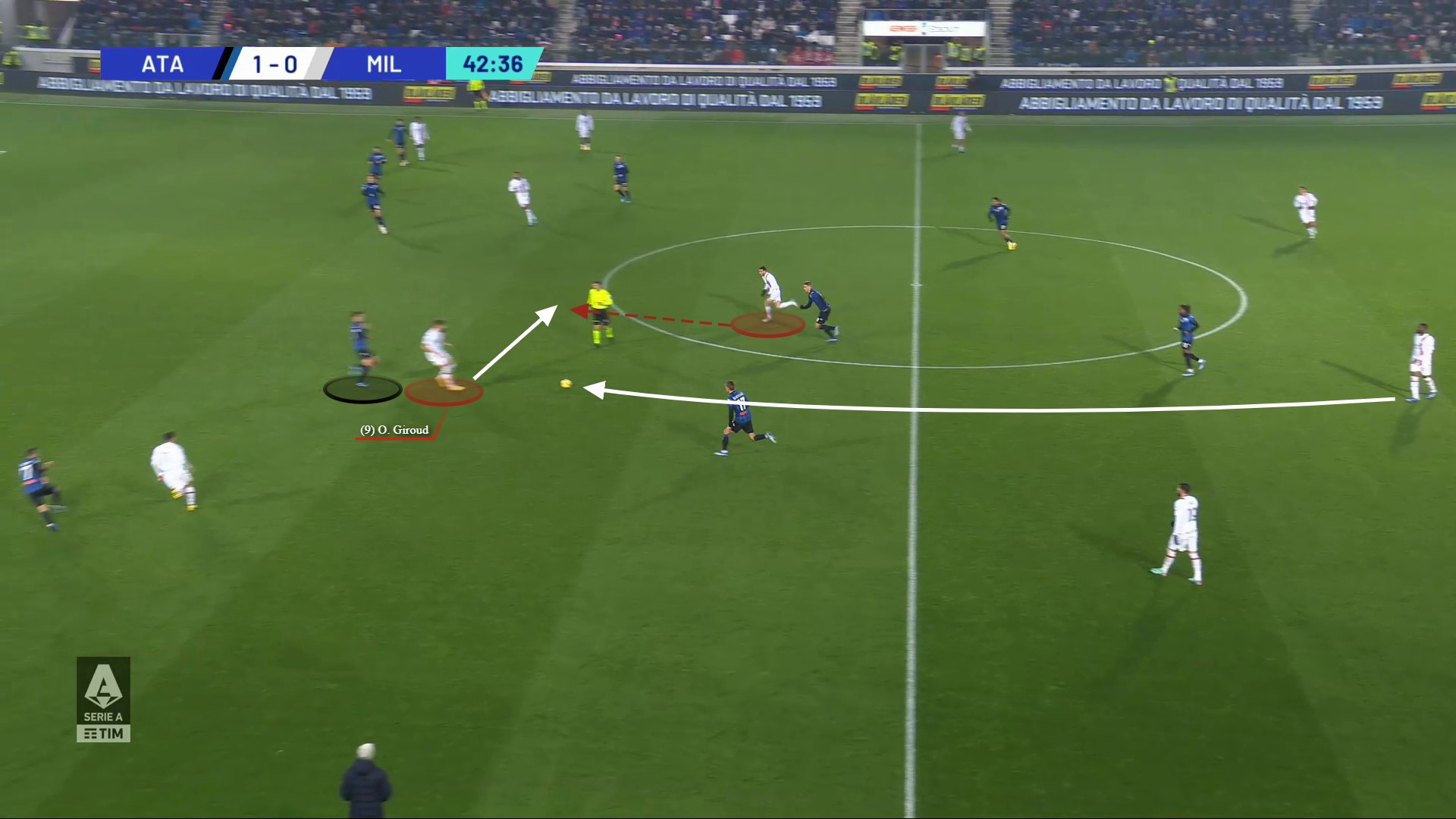
Milan had again managed to execute the first part of their attacking tactics successfully (bait and beat the opposition press, to then attack a disjointed defensive shape), but were again let down by a lack of quality in or when entering the final third. On this occasion, Florenzi’s attempted through ball was easily cut out by Scalvini when Milan had multiple runners in behind.
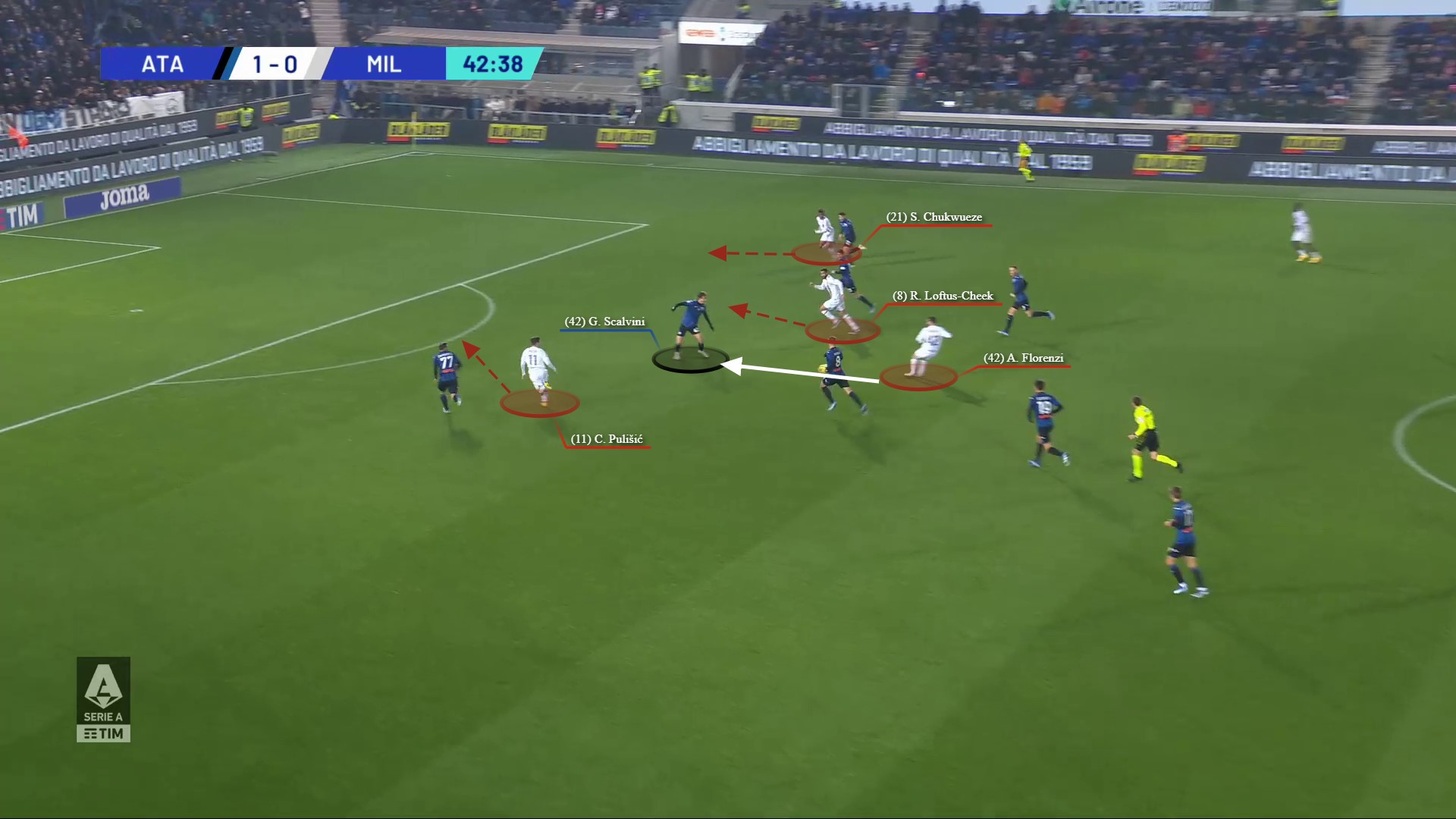
By the interval, Milan led the shot count 8-4 with a superior xG too (0.81 – 0.52). As seen through the various examples above, the Rossoneri had plenty of other attacking moments too which failed to be turned into tangible events in the statistics.
But for the vast majority of fans, the most important statistic was, and always will be, the scoreline. And this was 1-1. Despite Atalanta’s lower share of possession, the home side still caused Milan defensive problems in the opening forty-five minutes and this continued into the second half, making Milan’s failure to maximize their first-half control even harder to stomach.
Switches of play
A recurring tendency of Atalanta’s attacking tactics were switches of play. Like Milan, the home team aimed to use possession to manipulate the opposition’s defensive structure and then exploit spaces it had helped manufacture.
In Atalanta’s case, this involved working the ball from one side of the pitch to the other, predominantly to take advantage of Milan’s weak side but also to try and create gaps to penetrate centrally.
Here are some examples of this tactic in practice, starting with the passage of play which led to Charles De Ketelaere missing a sitter against his parent club in the 9th minute.
Play started with a Atalanta throw-in on their left-hand side, and play was switched over to the right wing towards Marten de Roon, the right centre-back.
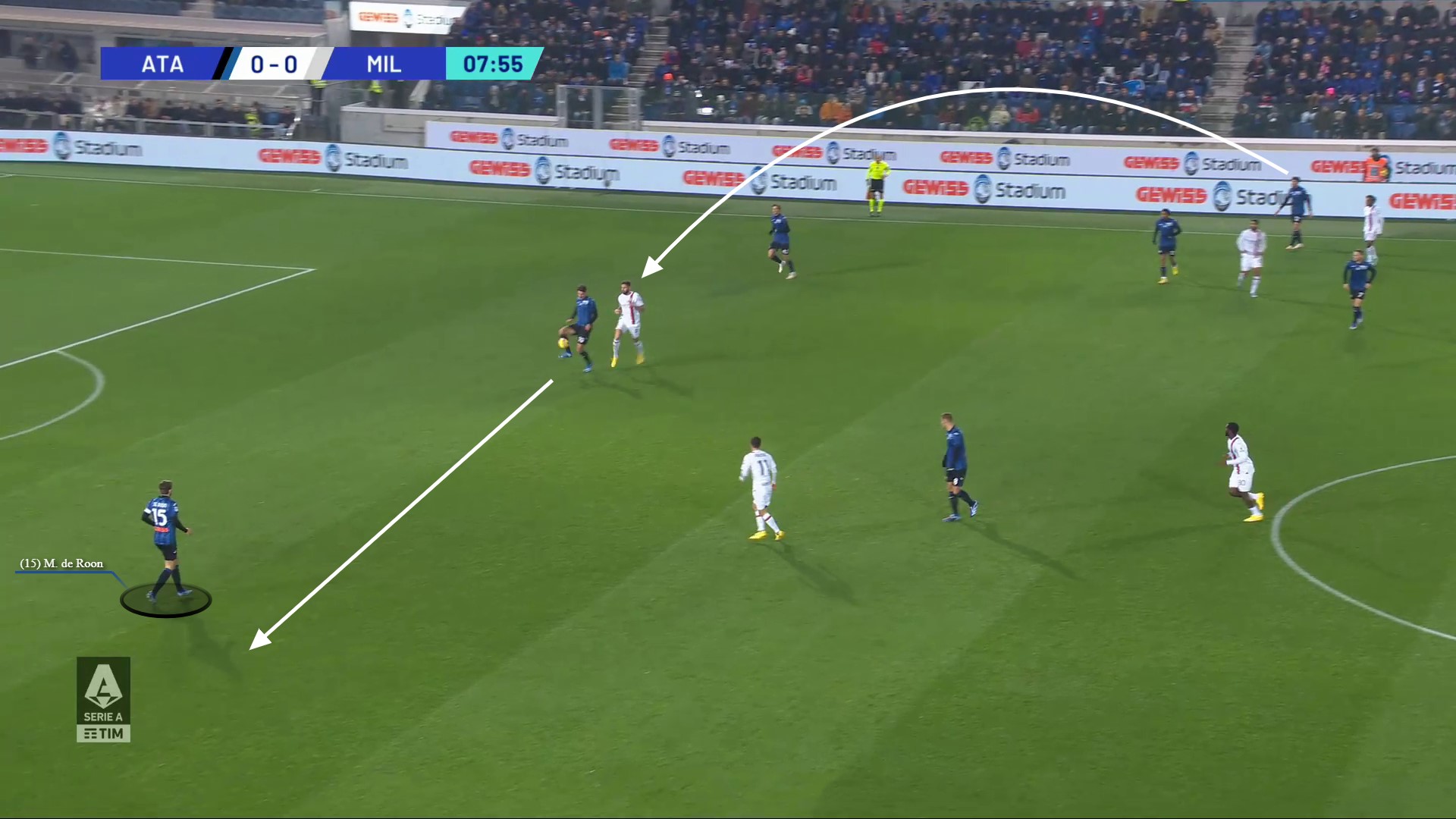
Below you can see Milan’s player-orientated approach when pressing Atalanta, with their front three locked onto their designated opponent in the back three, their three midfielders going player-for-player, and the ball-side full-back (Florenzi in this case) jumping to engage the wing-back. After carrying over to the right touchline, de Roon makes a forward pass to…
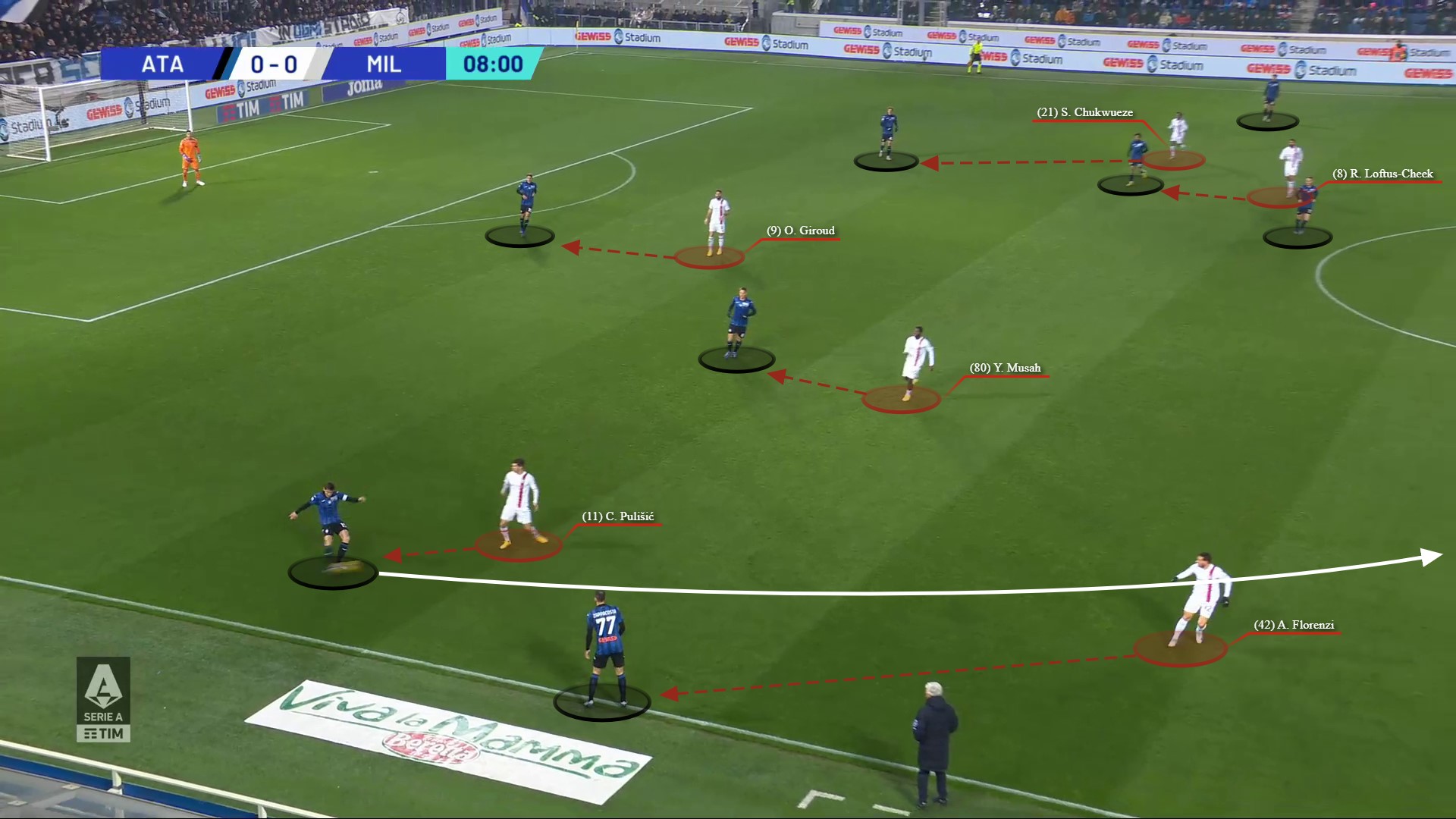
…the dropping De Ketelaere who wins the physical duel versus Hernández and immediately looks to switch play, back over to the left wing. From here, Lookman carried towards the box, exchanged passes with a teammate before Atalanta clipped a cross into the box which Lookman not only won without any contest, but also cushioned into the path of De Ketelaere who blazed over from 6-yards out.

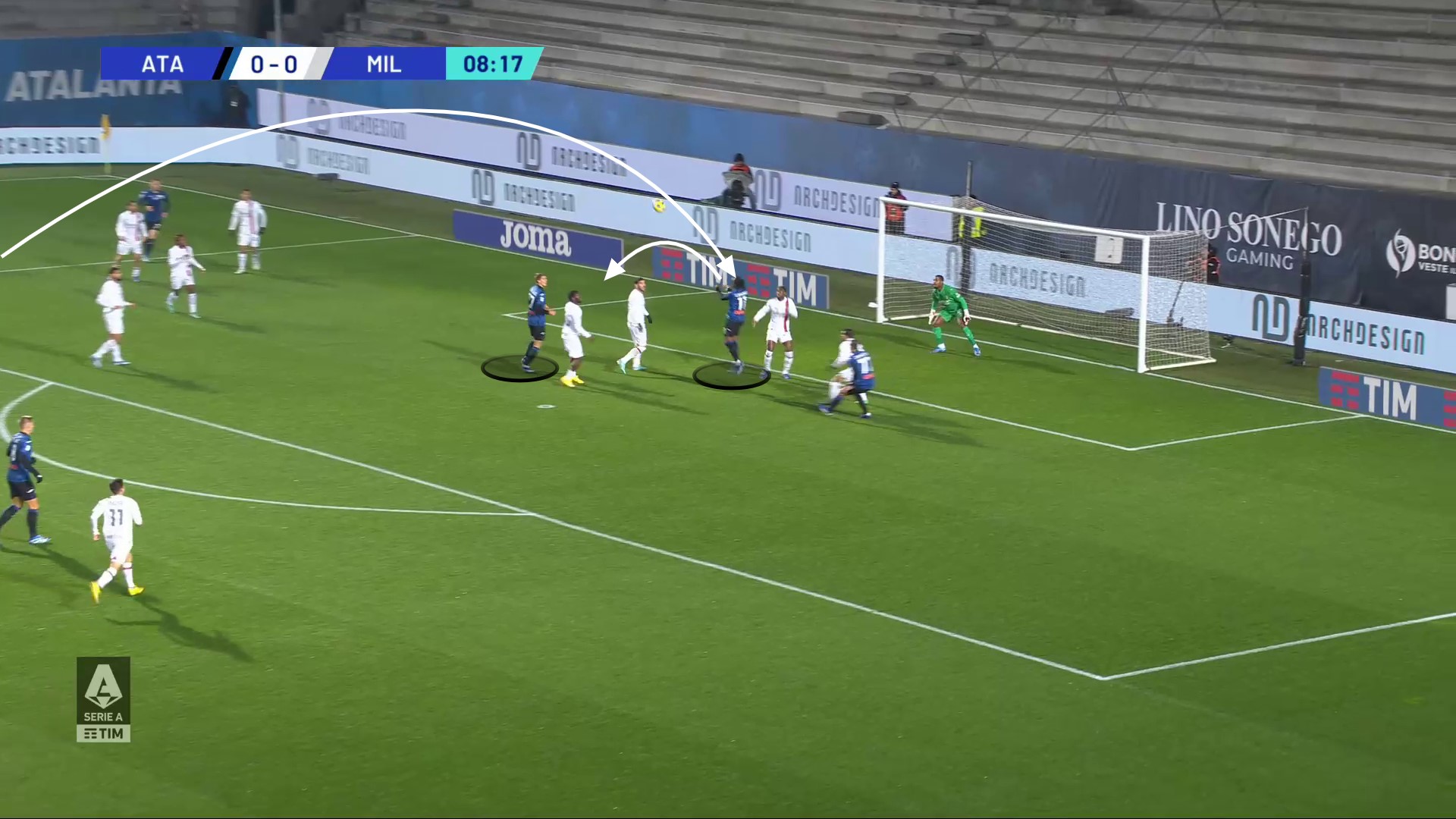
Here is another example of these switches from the 22nd minute. Lookman received a line breaking pass and then his momentum took his ball carry towards the right wing. But he knew the plan of attack, so he recycled the ball to the advanced de Roon who switched play to the left wing.

After exchanging some passes on this flank, Atalanta again worked the ball infield, before switching play back to the right-hand side where it was immediately sent back inside. As you can see in the 2nd image, the Milan backline had been suitably separated resulting in Atalanta…
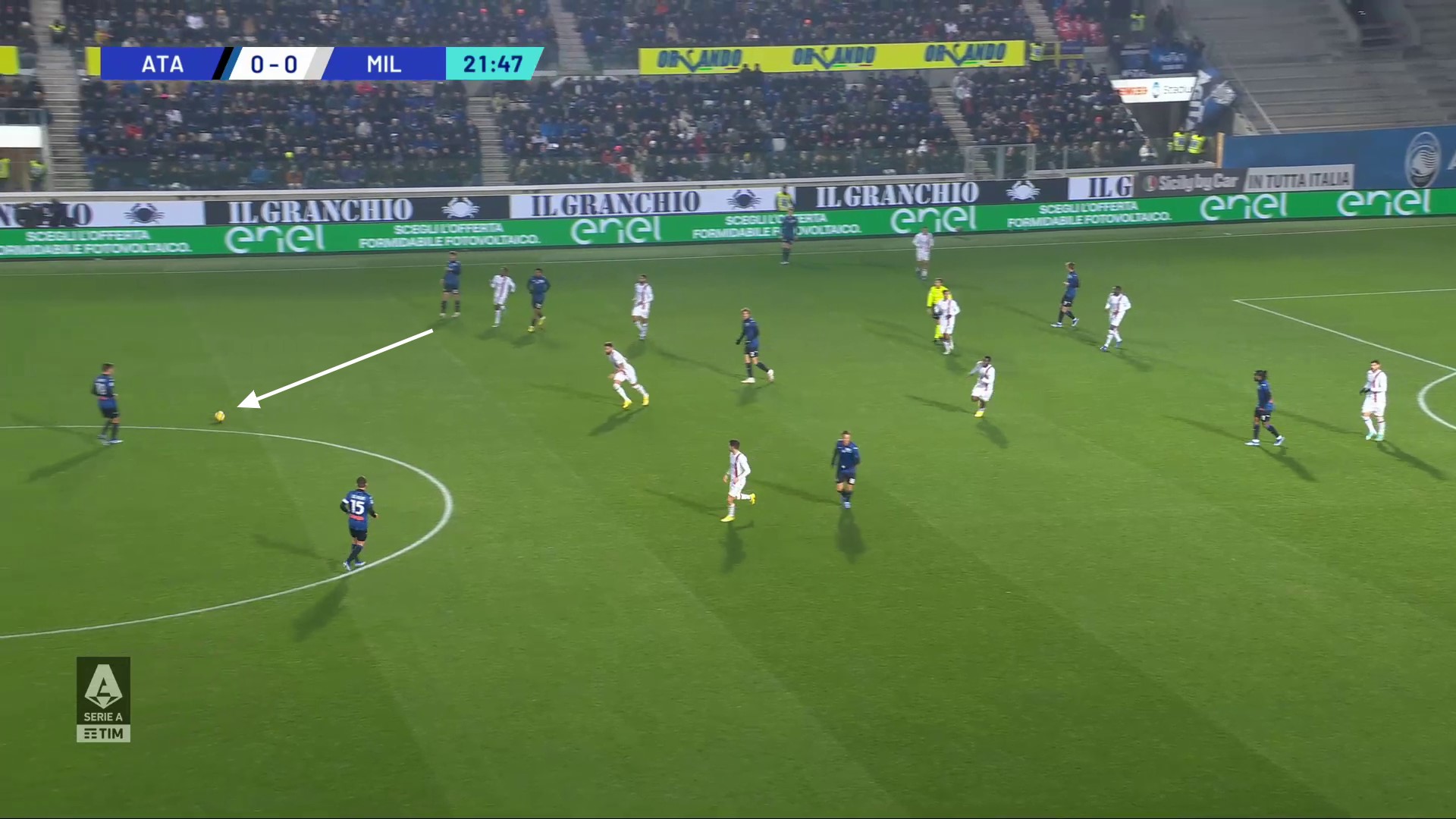
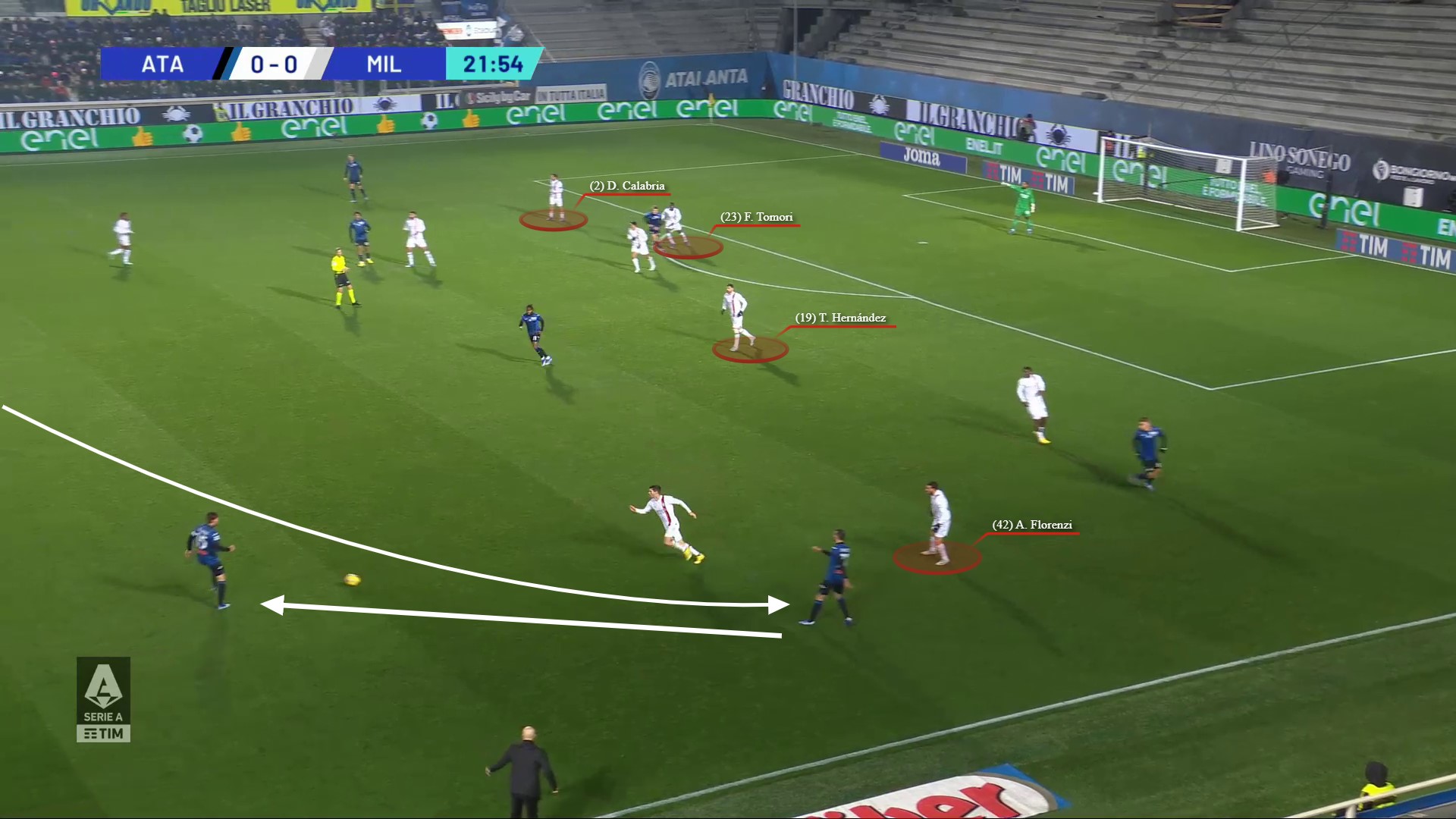
…executing a through ball for De Ketelaere’s curved (and untracked) run into the gap Hernández had vacated. Luckily for Milan, they were able to deal with this situation.
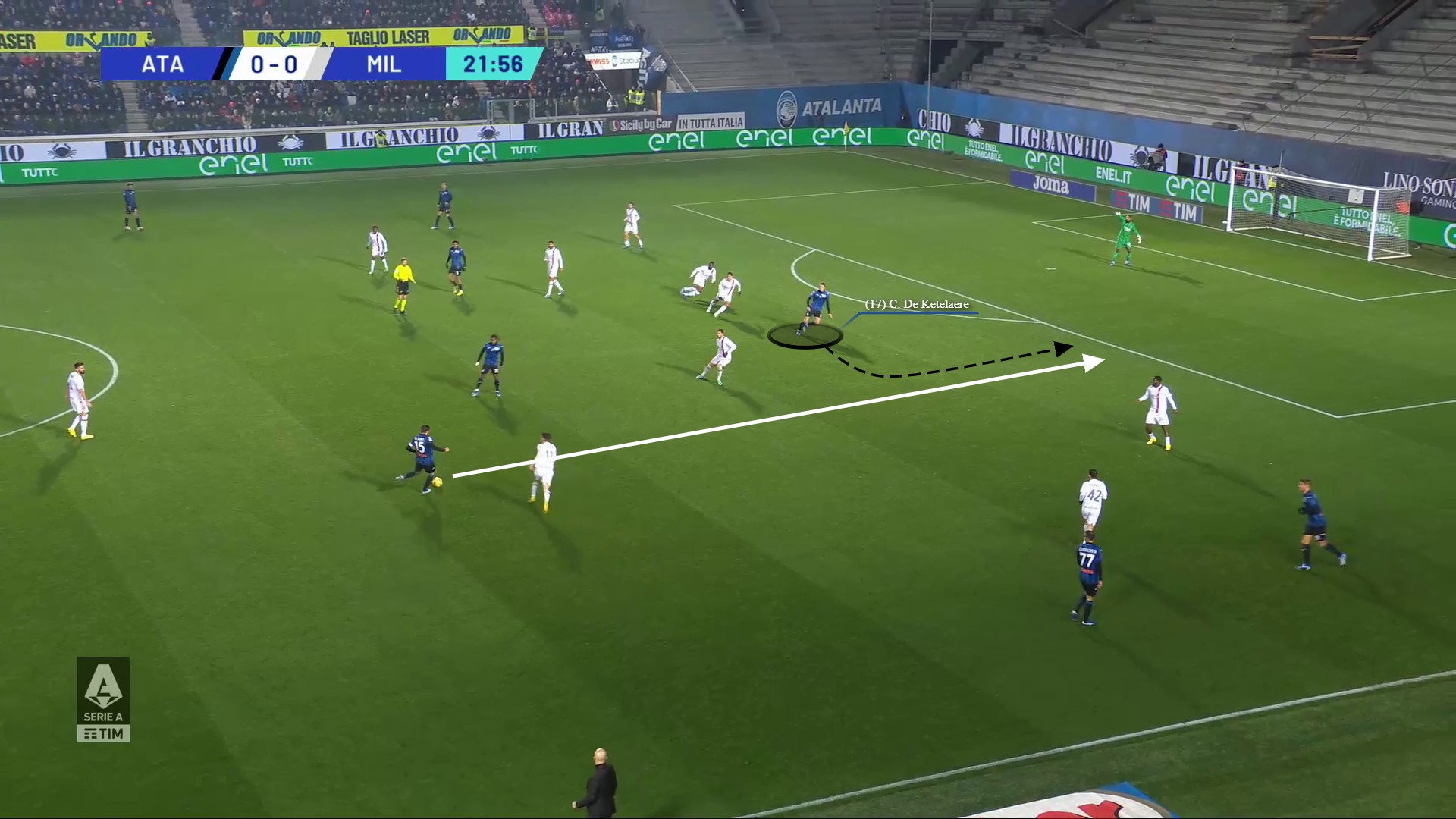
Atalanta also looked to utilise their build-up to manufacture opportunities to create switches of play. In this sequence from the 28th minute, the home team worked the ball out via their left-hand side (again, see the Milan player-orientated approach when pressing).
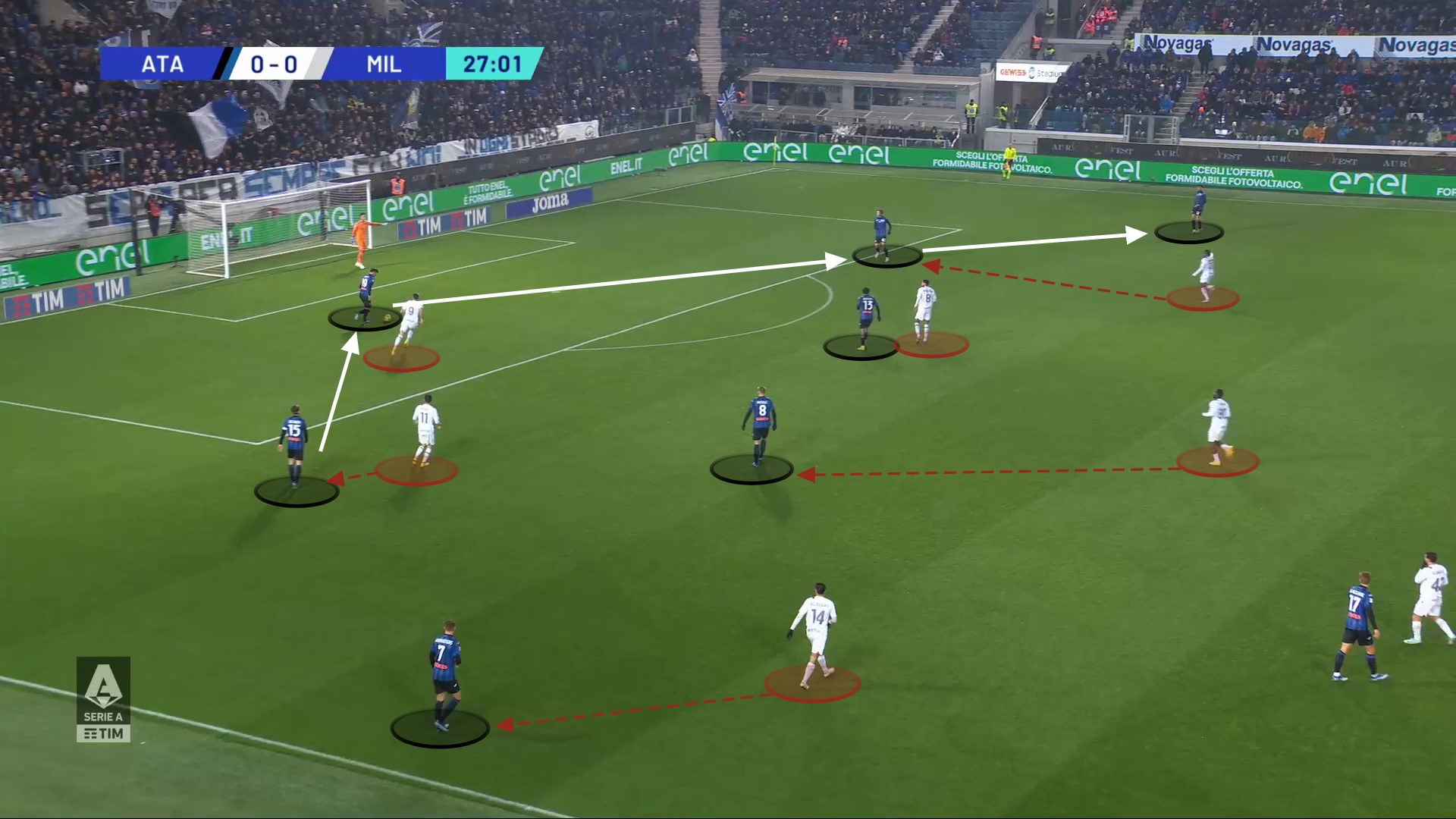
As per Milan’s pressing scheme, the ball-side full-back (Calabria in this case) jumped to engage the unmarked wing-back but not quick enough to prevent the forward pass into Lookman’s feet.
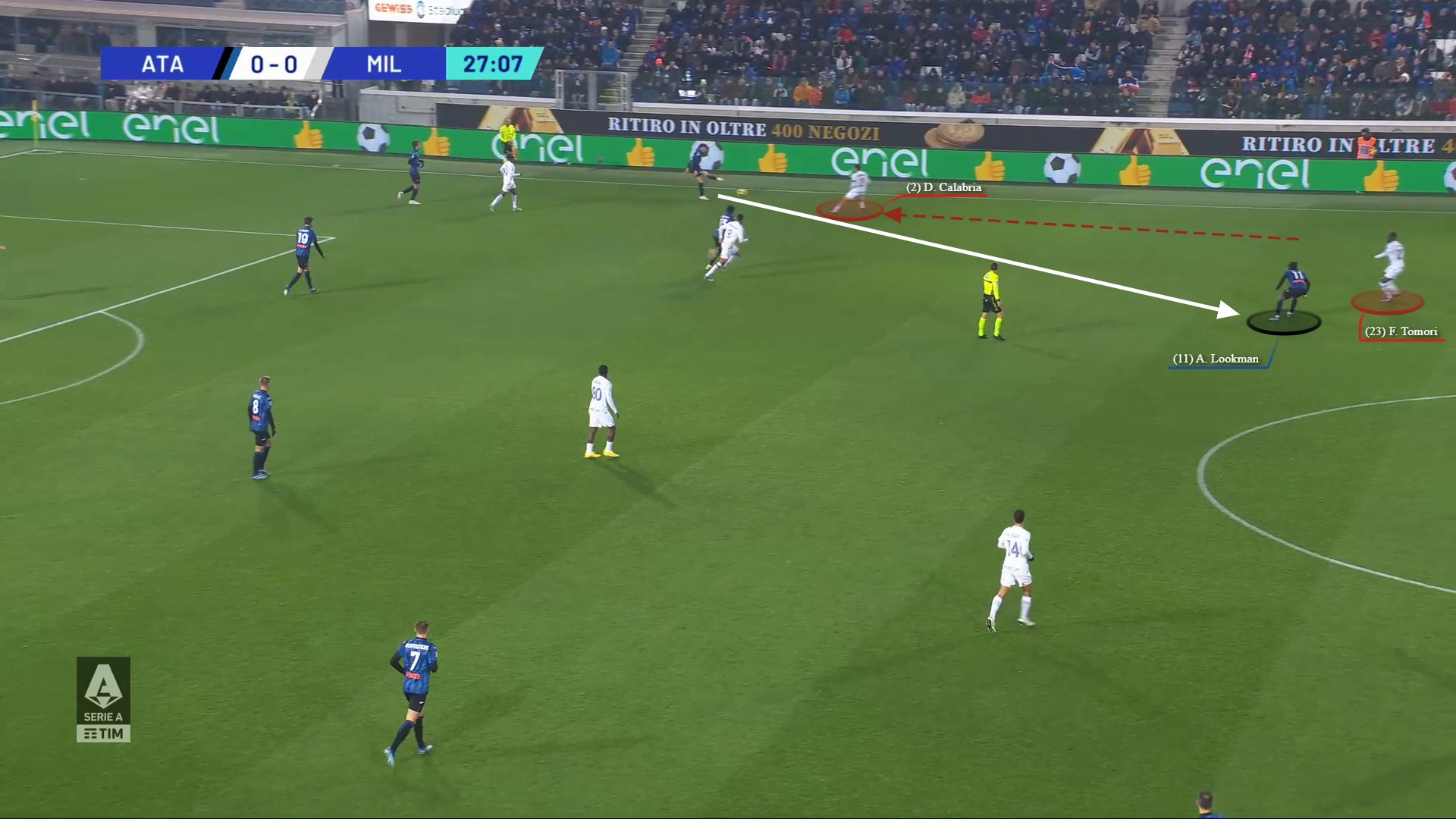
After receiving the ball, Lookman immediately looked to penetrate down the opposite flank. In this instance, Atalanta tried to go in behind the Milan backline via the channel but were fortunate that De Ketelaere was adjudged to have fouled Hernández, who used a bit of gamesmanship to buy the freekick when he realised his opponent had the advantage.
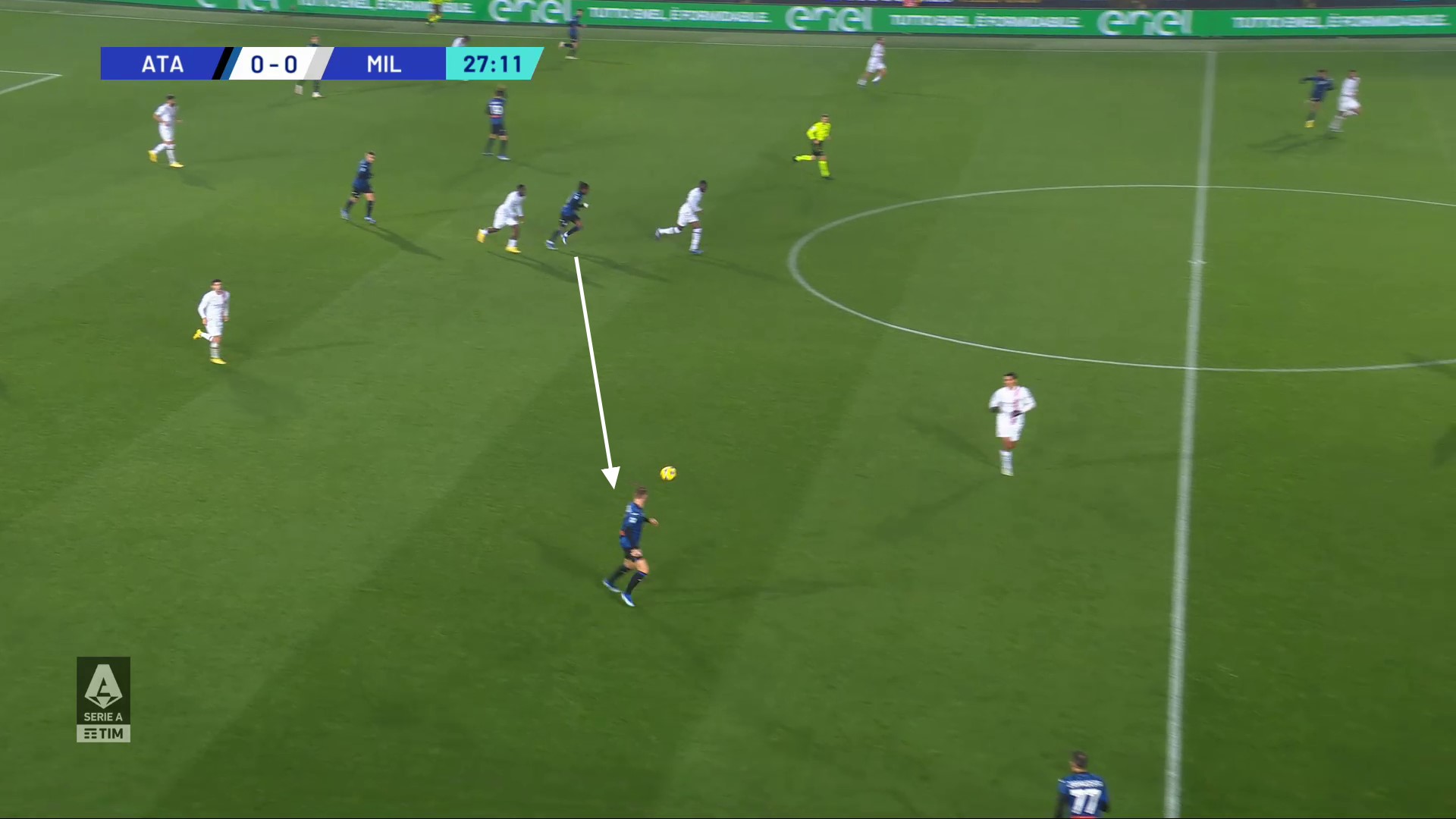

Another similar build-up scenario occurred in the 35th minute, but on this occasion, after playing out again via their left-hand side, Atalanta, maintained the attack on that flank – which helped drag Milan over further – before switching to the weak side. In this attack, Davide Zappacosta managed to cross into the box but the resulting shot was blocked by a Milan defender.
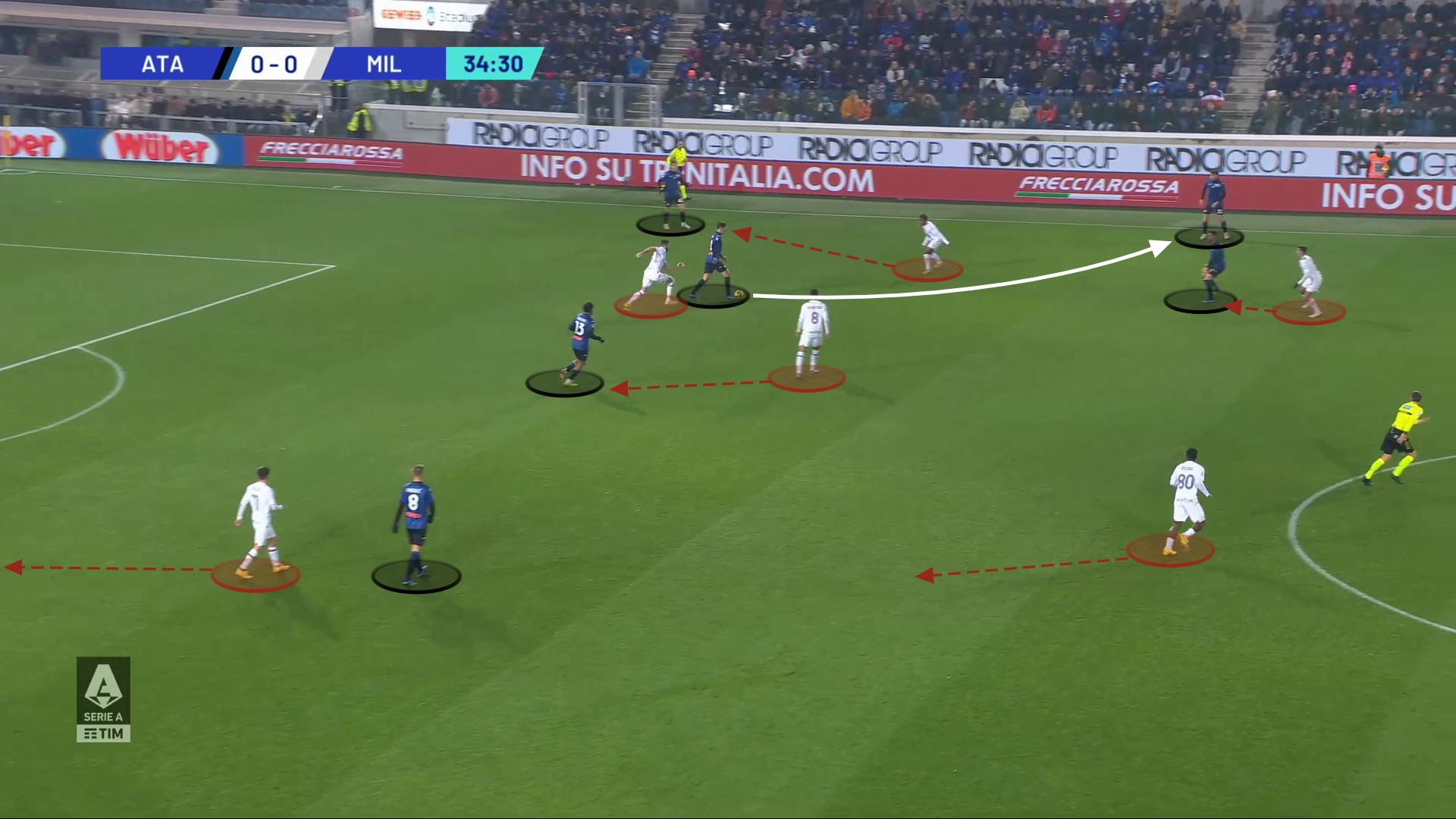
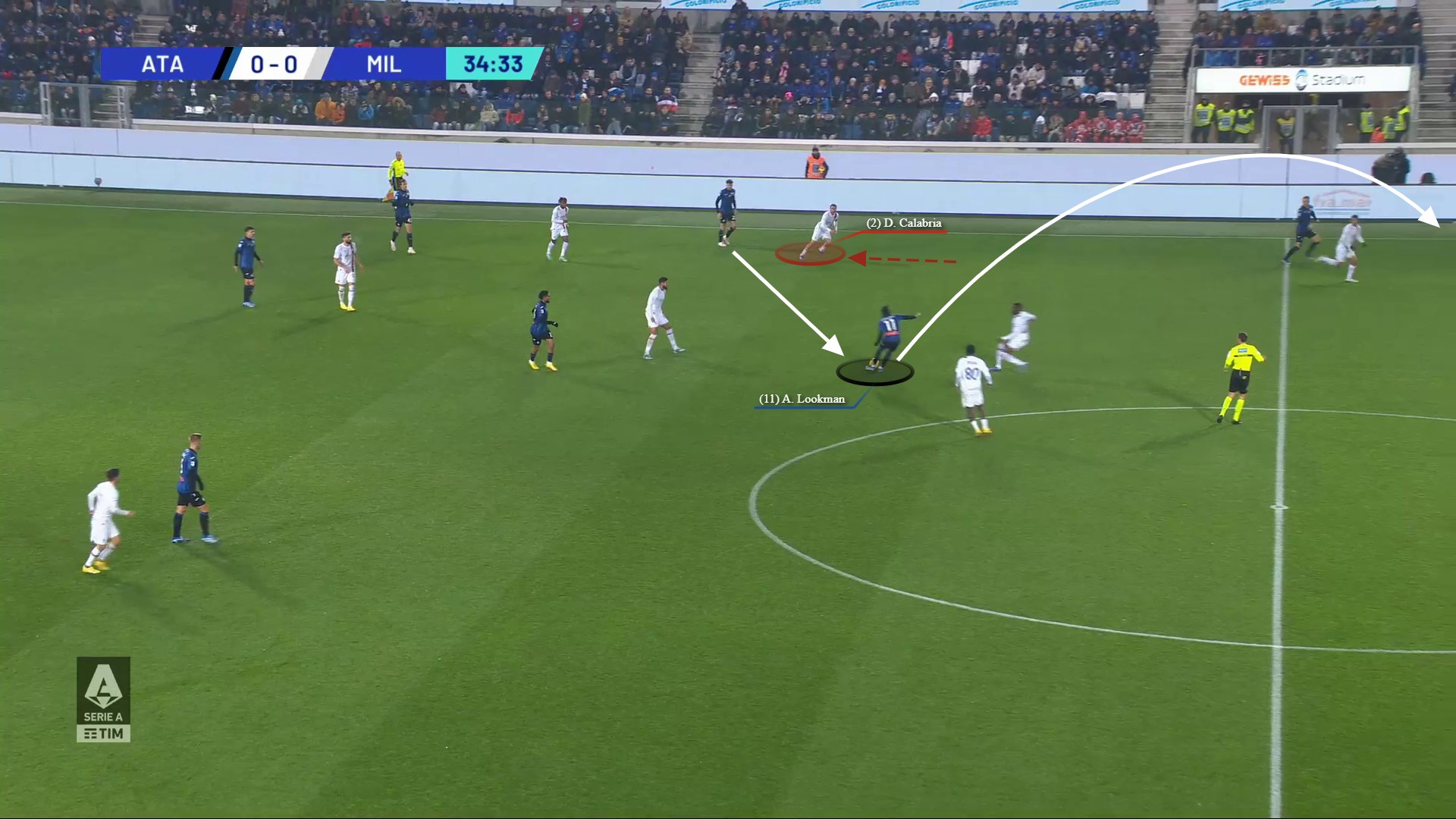
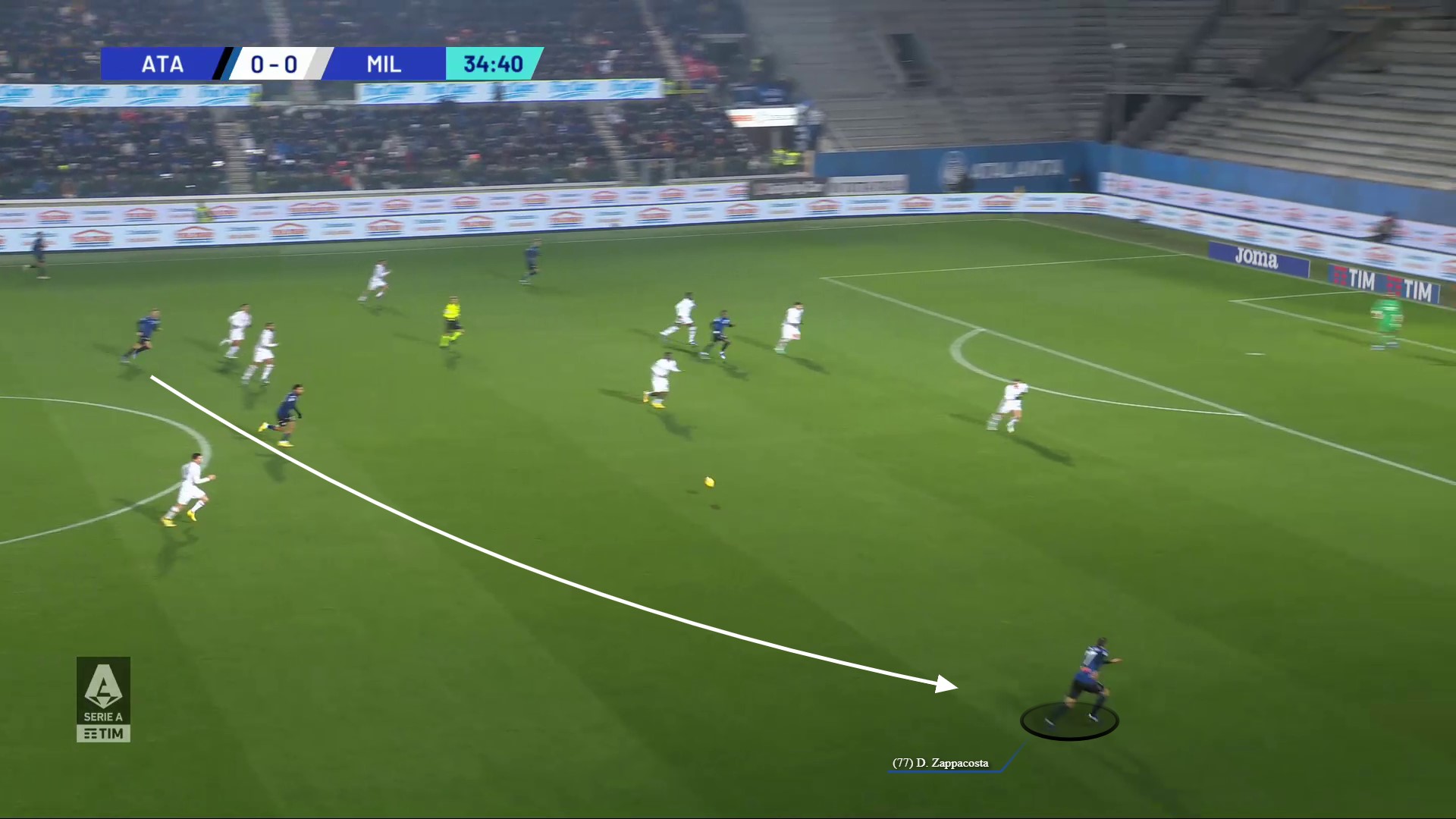
In the second half, Atalanta continued to use switches of play to their advantage, and had more opportunities to benefit with their increased possession. Through more of the ball, the home side took control of the opening period after the break and got their reward in the 55th minute.
Whilst the lead up this attack did not involve switches of play, it did involve Hernández switching off, with Lookman making a blindsided run behind the makeshift centre-back to get goalside for De Ketelaere’s cross to allow for a simple tap-in.
Pivotal moments
The introduction of Jović and change of shape, in (3-2-5) and out of possession (5-2-3), was the most interesting tactical aspect of the final twenty minutes of the game. But whilst games are often influenced by tactics, they are also regularly decided by specific moments.
And Calabria’s dismissal did not help Milan in the closing minutes of the game. Nor did Pulisic failing to keep hold of the loose ball he regained. Fingers will also likely point towards Hernández deciding to step out of the defensive line, consequently creating a gap in behind that substitute Aleksei Miranchuk exploited. But nothing can take away from the ingenuity of Muriel’s finish to seal the winner.
These pivotal moments helped decide the ultimate fate of the game. And with a pivotal fixture ahead this midweek, determining the fate of Milan’s 2023/24 European campaign, rumours are rife that this could also be a pivotal week in the future of Stefano Pioli.
All stats referenced in this article were sourced by Wyscout and FBRef.

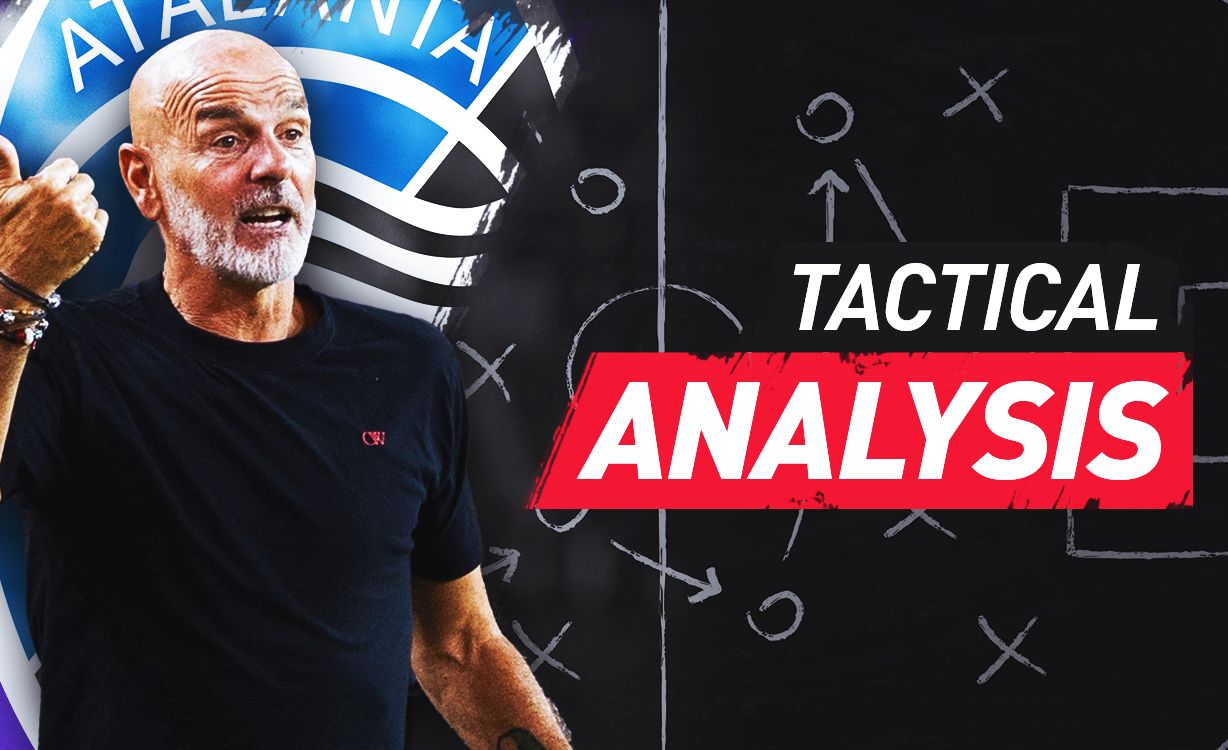
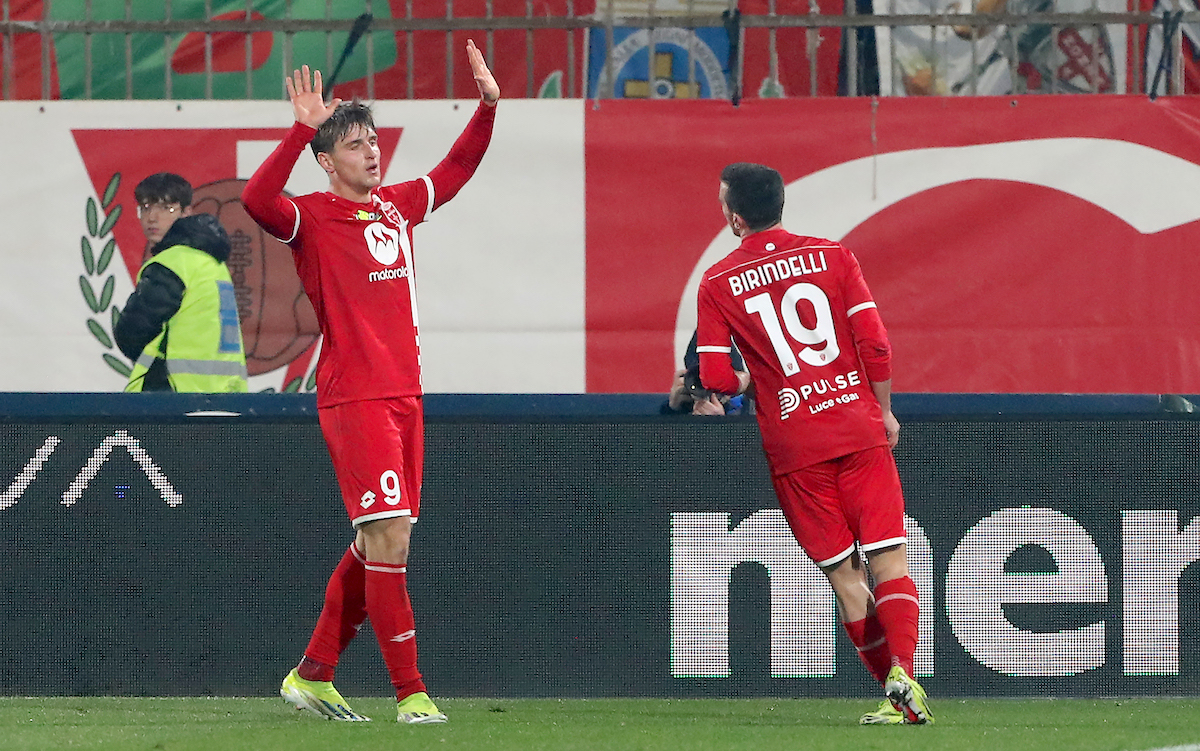
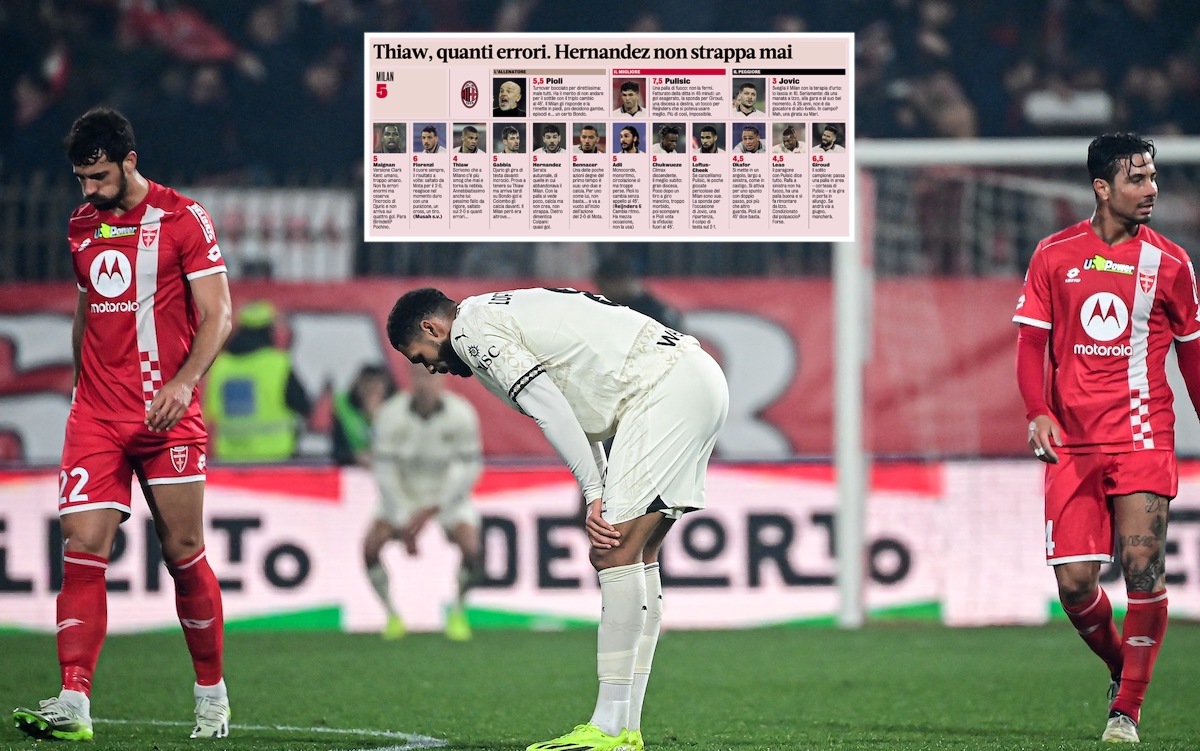

Go and rewatch the start of our build up just before Atalanta’s second goal. That part sums up our non existent system. It starts at 53 minutes. They had us chasing the ball like a bunch of amateurs. It’s like watching a local Sunday league match.
I’m amazed you can even make any sense of their tactics. I think you are being too generous. Milan play like a bunch of kids in gym class where the teacher just rolls the ball out and says go play.
Nobody other than Giroud seems to have a real position. Forget about playing a high line or a deep line, there doesn’t seem to be any line at all.
Pioli would benefit from the K.I.S.S. system. Keep It Simple Stupid.
With all the injuries and guys not playing their natural position, a simpler approach would be the wise one. Play a compact deep line and hit on the counter. This is what Milan do best anyways. Everyone seems to realize this except Pioli. This is why teams let Milan have possession and are not worried about it at all. Inter showed everyone, just sit back, invite Milan to have the ball and push forward and then strike on the counter when all of our players are way out of position and scrambling to get back.
Pioli’s stubbornness to try and force this team to be something that they are not and don’t have the players to pull off is what is taking this team down.
“Milan play like a bunch of kids in gym class where the teacher just rolls the ball out and says go play.
Nobody other than Giroud seems to have a real position. Forget about playing a high line or a deep line, there doesn’t seem to be any line at all.”
This. No one knows how they’re supposed to play. Why? Because no one tells them. Who should that be, I wonder….
Oh I forgot… The last comment was sarcasm. I know there are many who wouldn’t recognize it even if it bit them on their ass.